Please help the National Weather Service spread these important safety messages on social media! Everyone is welcome to use the text and images provided below to help the NWS build a Weather-Ready Nation.
Alerts and Forecasts
Facebook
A Winter Storm WATCH means Be Prepared.
A Winter Storm WARNING means Take Action!
weather.gov/safety/winter-ww
X
A Winter Storm WATCH means Be Prepared.
A Winter Storm WARNING means Take Action!
weather.gov/safety/winter-ww #WeatherReady
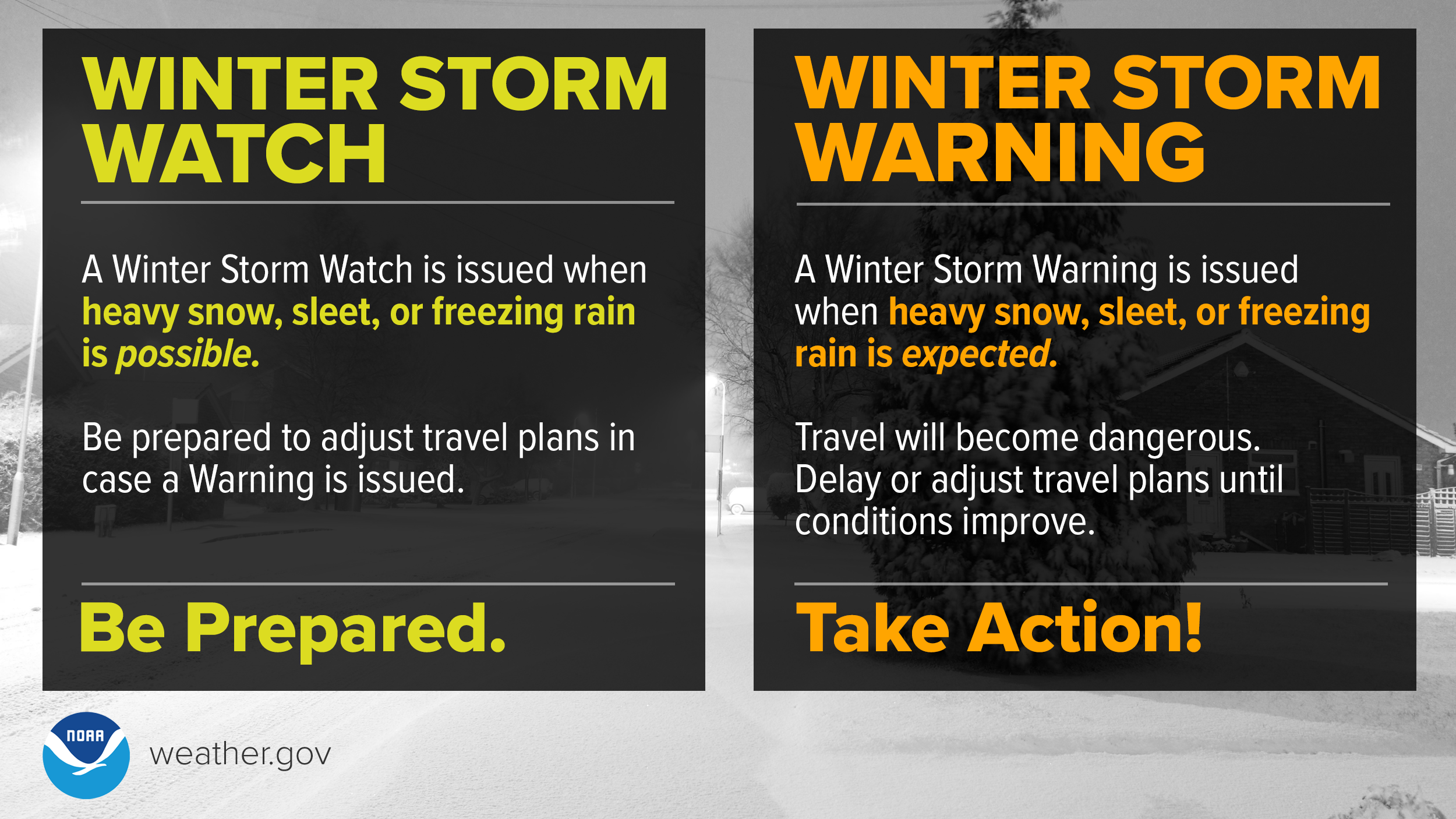
Facebook
An Extreme Cold WATCH means Be Prepared.
An Extreme Cold WARNING means Take Action!
weather.gov/safety/winter-ww
X
An Extreme Cold WATCH means Be Prepared.
An Extreme Cold WARNING means Take Action!
weather.gov/safety/winter-ww #WeatherReady
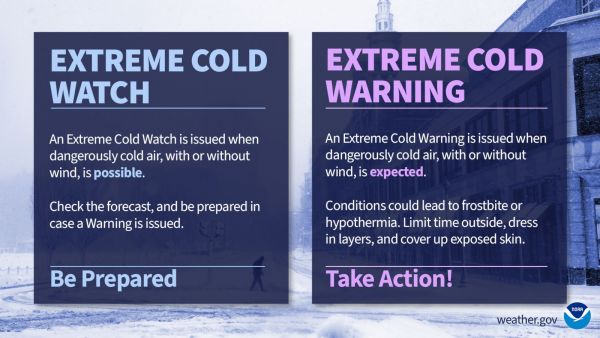
Facebook
An Avalanche WATCH means Be Prepared.
An Avalanche WARNING means Take Action!
avalanche.org
X
An Avalanche WATCH means Be Prepared.
An Avalanche WARNING means Take Action!
avalanche.org #WeatherReady
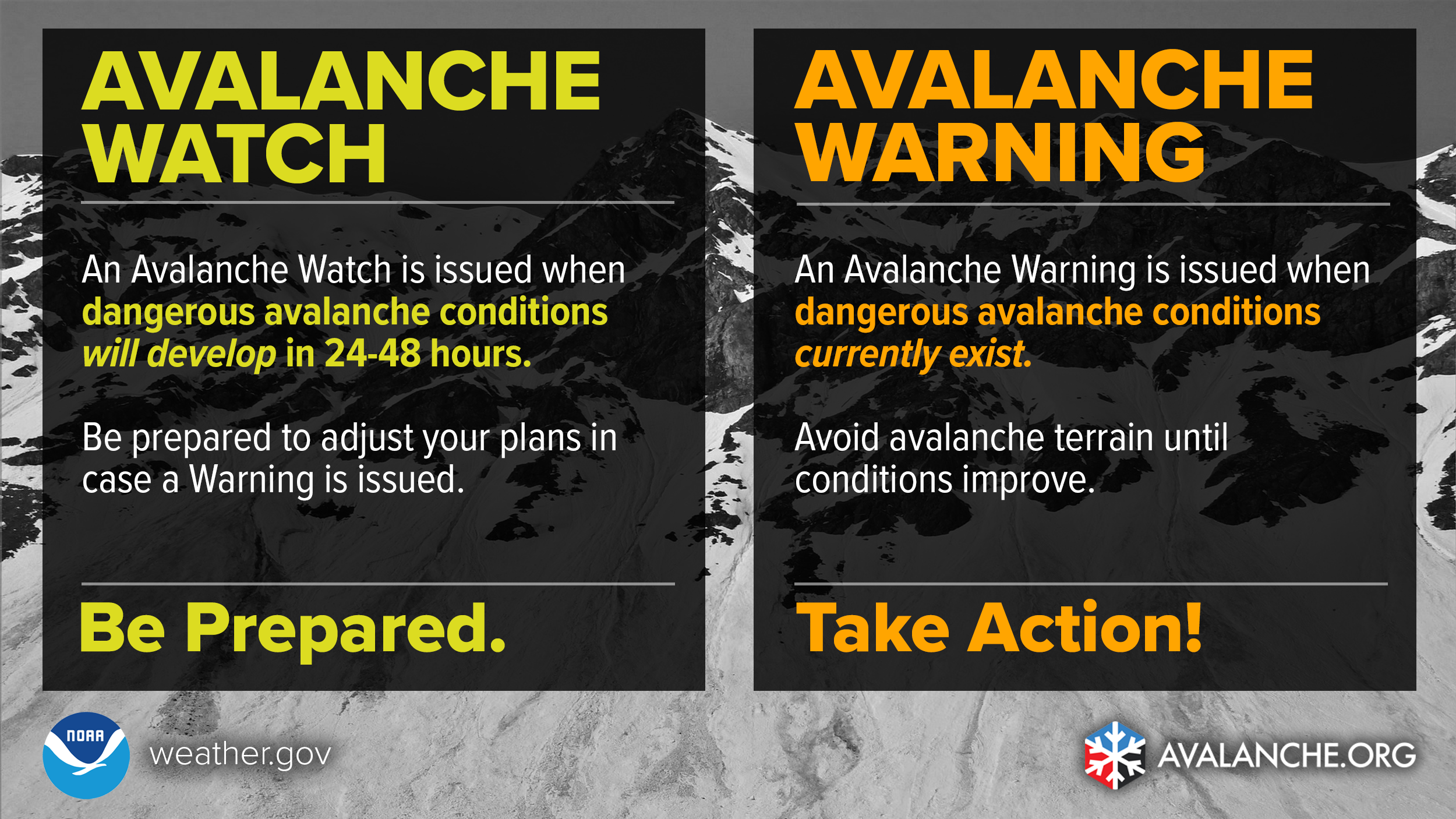
Facebook
Did you know that a one or two degree temperature difference can play an important role in whether we get rain, sleet, or snow? Learn more about how we get accurate forecasts here: youtube.com/watch?v=niPqFAtq8_E
X
Did you know that a one or two degree temperature difference can play an important role in whether we get rain, sleet, or snow? Learn more about how we get accurate forecasts here: youtube.com/watch?v=niPqFAtq8_E #WeatherReady
Facebook
Impacts from winter storms can vary a lot, even across short distances, and it can be difficult to pinpoint exactly which areas will be most impacted. Learn more about the Winter Storm Severity Index here: youtube.com/watch?v=u_rLZicceTc
X
Impacts from winter storms can vary a lot, even across short distances, and it can be difficult to pinpoint exactly which areas will be most impacted. Learn more about the Winter Storm Severity Index here: youtube.com/watch?v=u_rLZicceTc #WeatherReady
Facebook
We work hard to provide you with the most accurate forecasts possible, and our forecasts get more precise the closer we get to a big weather event. Learn more about how we update our forecasts at youtube.com/watch?v=O19o47qWdSE
X
We work hard to provide you with the most accurate forecasts possible, and our forecasts get more precise the closer we get to a big weather event. Learn more about how we update our forecasts at youtube.com/watch?v=O19o47qWdSE #WeatherReady
Around the Home
Facebook
Prepare your home for winter weather emergencies! Winter storms can knock out power and keep you from traveling for days. Keep enough non-perishable food, water and medications for at least 3 days. Ensure you have warm clothing and blankets. Make sure you have an updated first aid kit. Charge your phone in advance and check for wireless emergency alerts. weather.gov
X
Prepare your home for winter weather emergencies! Winter storms can knock out power and keep you from traveling for days. Keep enough non-perishable food, water, medications for at least 3 days. weather.gov #WeatherReady
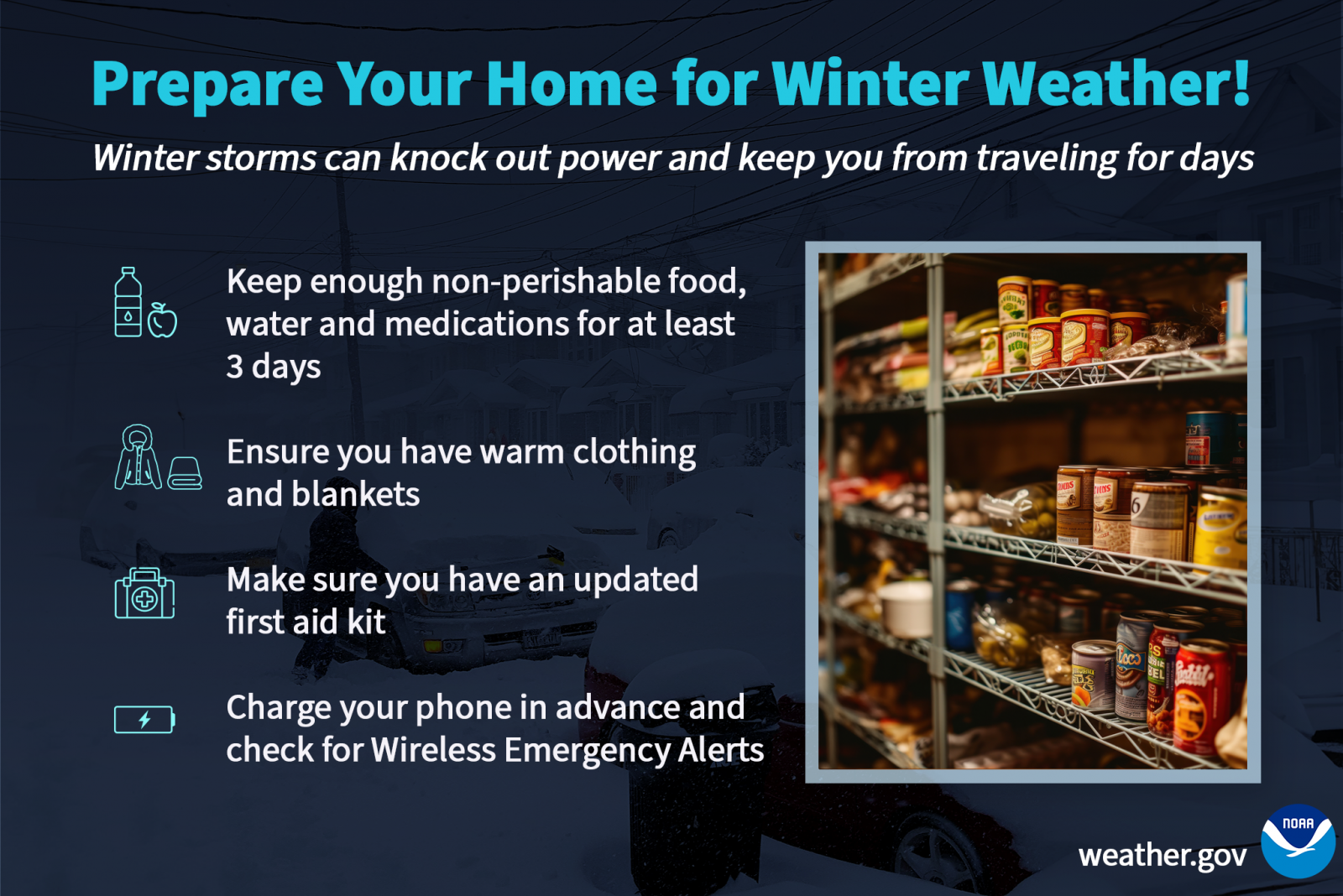
Facebook
As winter approaches, there are steps you can take to prepare your home for the cold weather ahead. Learn more at weather.gov/safety/winter
X
As winter approaches, there are steps you can take to prepare your home for the cold weather ahead. Learn more at weather.gov/safety/winter #WeatherReady
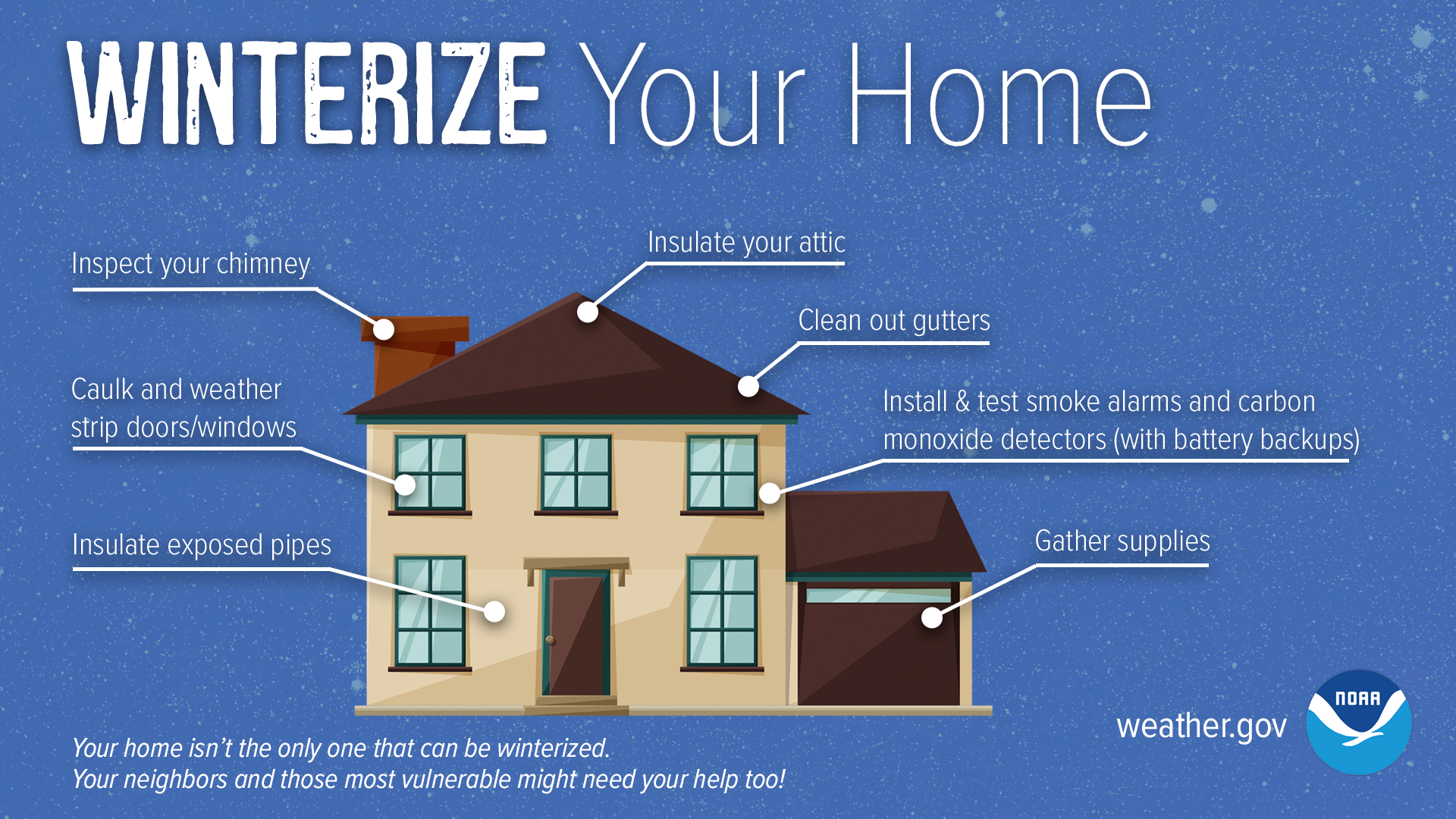
Facebook
Prepared for a possible polar plunge? As temperatures drop, remember to protect the 4 P’s: People, pets, pipes, and plants. weather.gov/safety/cold
X
Prepared for a possible polar plunge? As temperatures drop, remember to protect the 4 P’s: People, pets, pipes, and plants. weather.gov/safety/cold
#WeatherReady
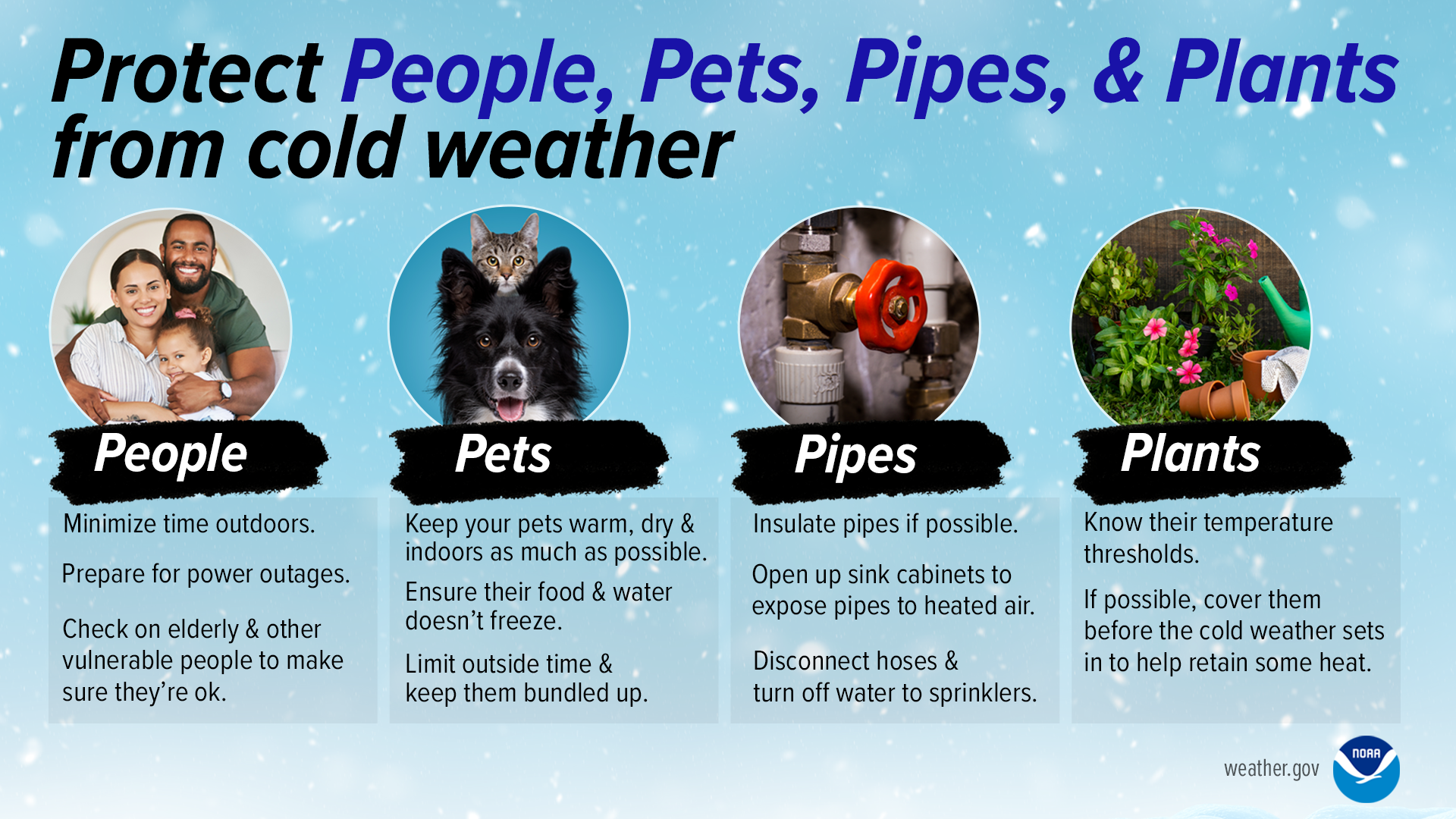
Facebook
Are you prepared for a winter storm? If the forecast calls for winter weather, begin preparing NOW. Don’t wait until the last minute. weather.gov/safety/winter-before
X
Are you prepared for a winter storm? If the forecast calls for winter weather, begin preparing NOW. Don’t wait until the last minute. weather.gov/safety/winter-before #WeatherReady
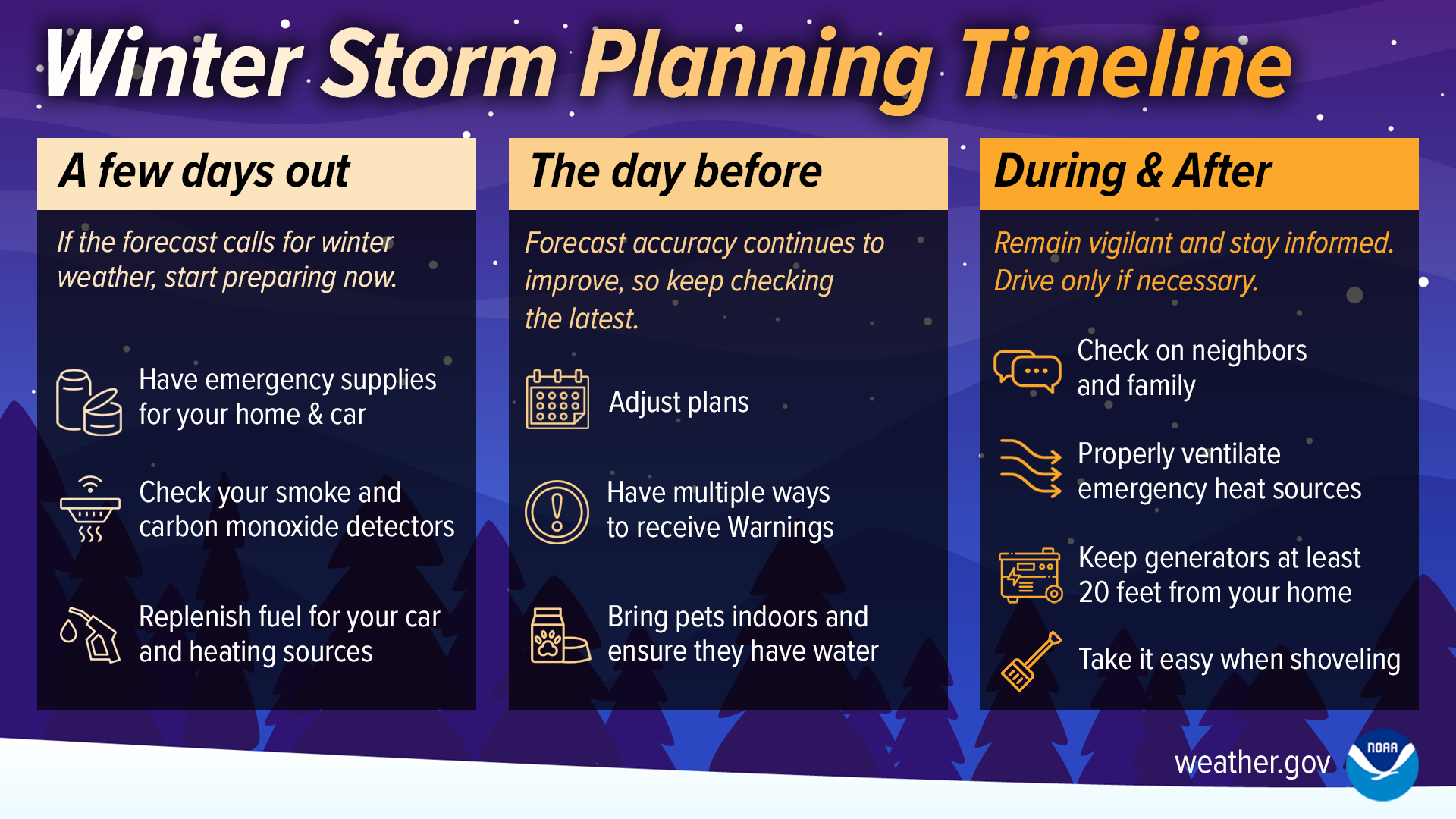
Facebook
Power outages are common after a big winter storm. If you lose power, make sure to be careful when using alternative heat sources and practice portable generator safety. Once you and your family are safe, check in with others in your neighborhood to make sure they are okay. weather.gov/safety/winter
X
Power outages are common after a big winter storm. Be careful with alternative heat sources, practice portable generator safety, and check in with neighbors to ensure that everyone stays safe. weather.gov/safety/winter
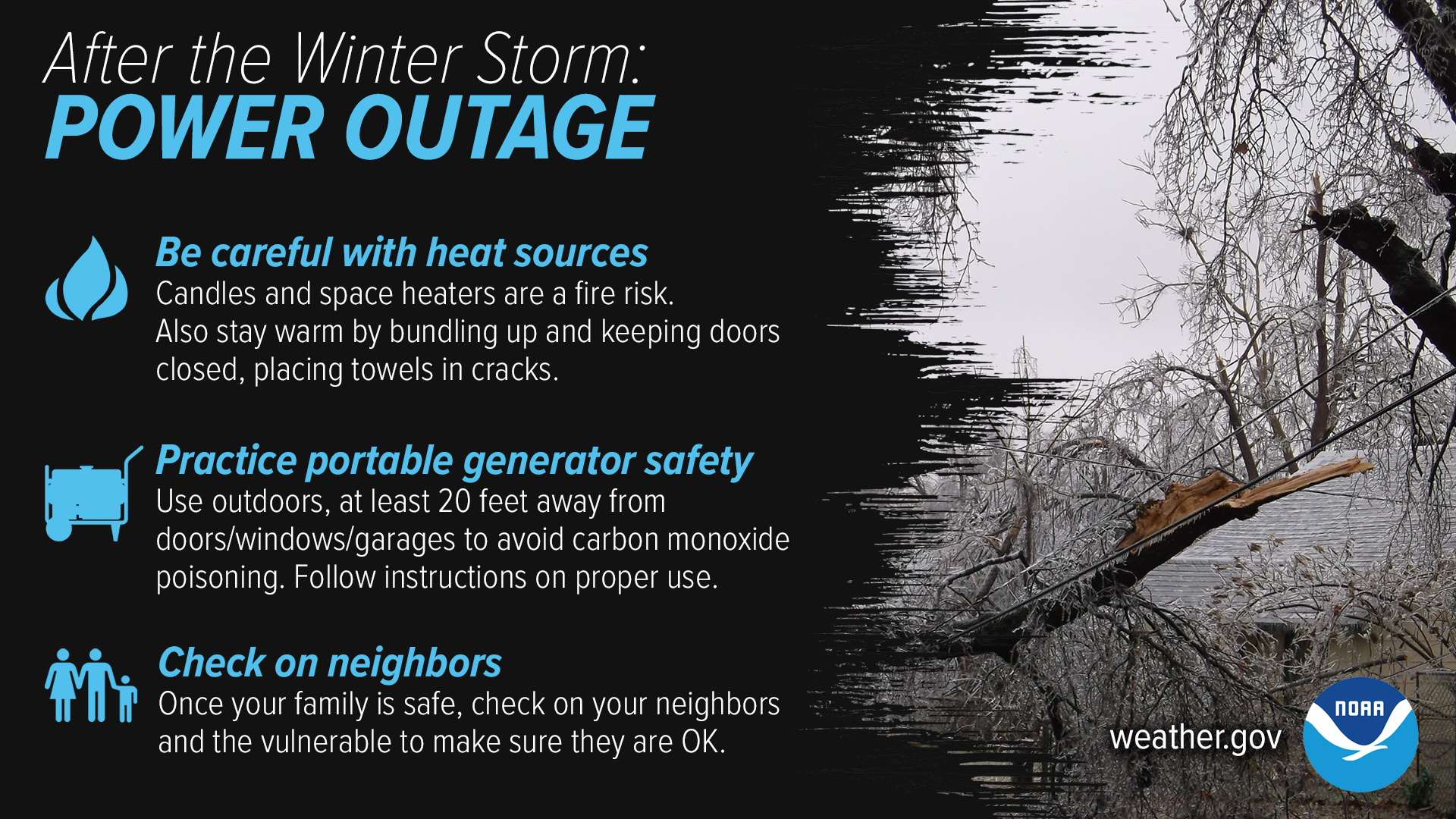
Facebook
When the power goes out in winter, the cold can be deadly--but even without power, there are still ways to warm things up. Closing blinds and curtains and closing room doors can help contain heat, and stuffing towels in the cracks under doors can help keep the warmth in. Don’t forget about eating and staying hydrated - food provides energy to warm the body.
Learn more about winter safety: weather.gov/safety/winter
X
When the power goes out in winter, the cold can be deadly. But even without power, there are still ways to warm things up. Stay #WeatherReady and learn more about winter safety: weather.gov/safety/winter

Facebook
Slipping on an icy sidewalk can lead to serious injuries or even death, especially for the elderly. Help prevent the formation of ice by salting walkways and turning off sprinklers in advance of cold weather.
Learn more ice safety at weather.gov/safety/winter-ice-frost
X
Slipping on an icy sidewalk can lead to serious injuries or even death, especially for the elderly. Help prevent the formation of ice by salting walkways and turning off sprinklers in advance of cold weather.
Learn more ice safety at weather.gov/safety/winter-ice-frost #WeatherReady

Facebook
Slippery sidewalks and roads aren’t the only things to look out for in late winter and early spring snow storms--shoveling snow can be a health risk as well. Remember to stay hydrated, take frequent breaks, and move only small amounts with each shovel pass. Learn more at weather.gov/winter
X
Shoveling snow can be a health risk, so remember to take it easy. Learn more at weather.gov/winter #WeatherReady

Facebook
Sleet can be deceptively dangerous - it’s much more dense than snow, so take it easy when shoveling.
Use extreme caution when driving during or after sleet. Reduce speed, allow plenty of stopping distance, and do not use cruise control.
Learn more winter safety at weather.gov/safety/winter
X
Sleet can be deceptively dangerous - it’s much more dense than snow, so take it easy when shoveling.
Use extreme caution when driving during or after sleet. Reduce speed, allow plenty of stopping distance, and do not use cruise control.
weather.gov/safety/winter #WeatherReady

Facebook
Is your home ready for an ice storm? Ice storms can cause power outages that can last up to several days, affecting both you and the surrounding area — that’s why it’s important to have a week’s supply of food and prescriptions. What else would you need?
Ice storms can easily break tree branches, so trim weak or damaged branches around your home, and don’t park your car under trees. After you’ve parked, don’t leave your wipers raised...contrary to popular belief, doing so increases the chance of wiper damage.
Learn more about ice storm safety: weather.gov/safety/winter-ice-frost
X
Is your home ready for an ice storm? Ice storms can cause power outages that can last several days and pose a threat to tree branches and anything underneath. Stay #WeatherReady and learn more about ice storm safety: weather.gov/safety/winter-ice-frost #WeatherReady

Health (Cold)
Facebook
Cold outside? Avoid the risk of frostbite and hypothermia by dressing in layers, covering exposed skin, and limiting time outdoors. If someone might be experiencing either condition, seek medical attention immediately — and know your actions. weather.gov/safety/cold-during
X
Cold outside? Avoid the risk of frostbite and hypothermia by dressing in layers, covering exposed skin, and limiting time outdoors. If someone might be experiencing either condition, seek medical attention immediately — and know your actions. weather.gov/safety/cold-during #WeatherReady

Facebook
Everyone is at risk from the dangers of extreme cold, but these groups are more vulnerable than most. Age and certain conditions make the body less able to regulate temperature.
Stay Weather-Ready and learn more about cold safety at weather.gov/safety/cold
X
Everyone is at risk from the dangers of extreme cold, but these groups are more vulnerable than most. Age and certain conditions make the body less able to regulate temperature.
Stay #WeatherReady and learn more about cold safety at weather.gov/safety/cold

Facebook
Don't forget about your pets this winter! Make sure they have a warm, dry place to rest with plenty of food and water. weather.gov/winter
X
You love your pets, so keep them warm, dry, and well fed this winter. weather.gov/winter #WeatherReady

Facebook
For those working outside during cold temperatures or winter weather, stay Weather-Ready and prepared. osha.gov/dts/weather/winter_weather/
X
For those working outside during cold temperatures or winter weather, stay #WeatherReady and prepared. osha.gov/dts/weather/winter_weather/

Facebook
Bundling up and staying dry are two of the best things you can do to stay safe from cold temperatures this fall and winter. Learn to protect yourself from the cold at weather.gov/safety/cold
X
Bundling up and staying dry are two of the best things you can do to stay safe from cold temps. Stay #WeatherReady and learn to protect yourself from the cold at weather.gov/safety/cold

Facebook
If you notice someone exhibiting warning signs of hypothermia, get them to a warm place right away. Learn more about how to protect yourself from the cold at weather.gov/safety/cold
X
Do you know the signs of hypothermia? weather.gov/safety/cold #WeatherReady

Facebook
When caught outdoors in a winter storm, there are life-saving actions you can take to protect yourself. Find (or make) shelter, cover exposed body parts, melt snow for drinking water, and exercise occasionally. weather.gov/safety/winter-during
X
When caught outdoors in a winter storm, there are life-saving actions you can take to protect yourself. #WeatherReady
weather.gov/safety/winter-during

Facebook
Cold weather can be life-threatening. If you can’t avoid being outside, remember to follow these 3 steps and make sure to always tell someone where you’re going. weather.gov/safety/cold
X
Cold weather can be life-threatening, so follow these 3 steps and make sure to always tell someone where you’re going. weather.gov/safety/cold #WeatherReady

Facebook
Protect yourself from extreme cold, whether it's the wind chill or air temperature – both are dangerous! weather.gov/winter
X
Protect yourself from extreme cold, whether it's the wind chill or air temperature – both are dangerous! weather.gov/winter #WeatherReady
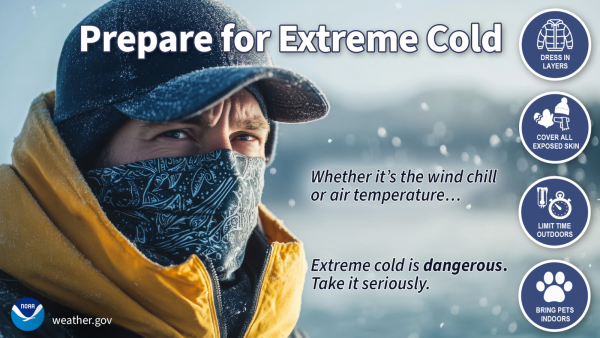
Driving
Facebook
Are you planning a lengthy trip by car this winter? Know how to prepare, and know that the decisions that need to be made will differ depending on where you are on the Winter Travel Timeline: youtu.be/ZzjarXUsDtA
X
Are you planning a lengthy trip by car this winter? Know how to prepare, and know that the decisions that need to be made will differ depending on where you are on the Winter Travel Timeline: youtu.be/ZzjarXUsDtA #WeatherReady
Facebook
If you’re going to be driving this winter, know how to stay safe. Winterize your vehicle and pack an emergency supply kit. Share your travel plans with friends and family. Before leaving, check road conditions and the weather forecast so you know to expect. weather.gov/safety/winter
X
If you’re going to be driving this winter, know how to stay #WeatherReady. Winterize your vehicle and pack a supply kit. Share your travel plans and, before leaving, check road conditions and the weather forecast. weather.gov/safety/winter
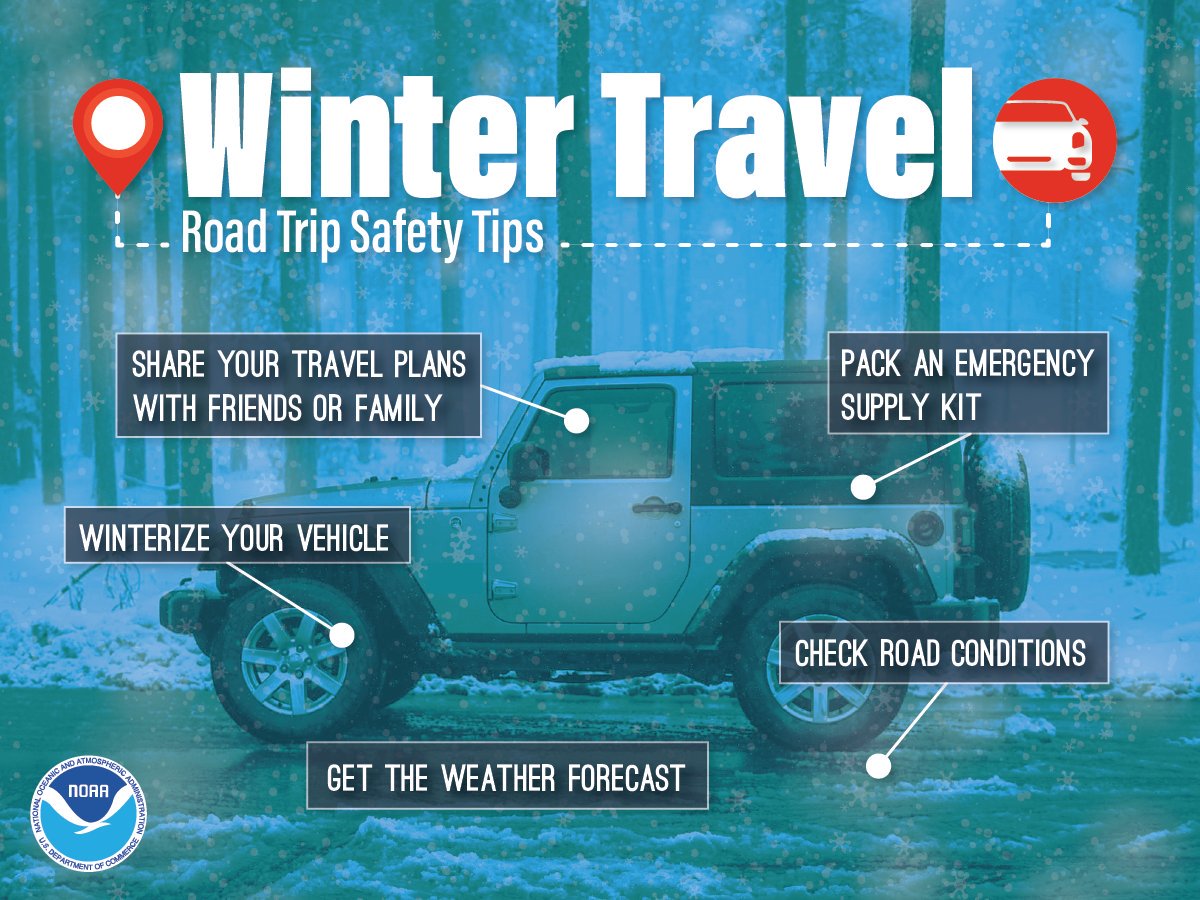
Facebook
Is your vehicle ready for the winter? Watch this brief video to know what needs to be in your emergency kit and how to winterize your vehicle: youtu.be/hcwl_bnID50
X
Is your vehicle ready for the winter? Watch this brief video to know what needs to be in your emergency kit and how to winterize your vehicle: youtu.be/hcwl_bnID50 #WeatherReady
Facebook
Even trucks and SUVs with four-wheel drive can still lose traction in the snow. Stay Weather-Ready by always using extra caution when driving in wintry conditions — no matter what you’re driving. Learn more winter safety tips at weather.gov/safety/winter
X
Even trucks and SUVs with four-wheel drive can still lose traction in the snow. Stay #WeatherReady by always using extra caution when driving in wintry conditions — no matter what you’re driving. Learn more winter safety tips at weather.gov/safety/winter
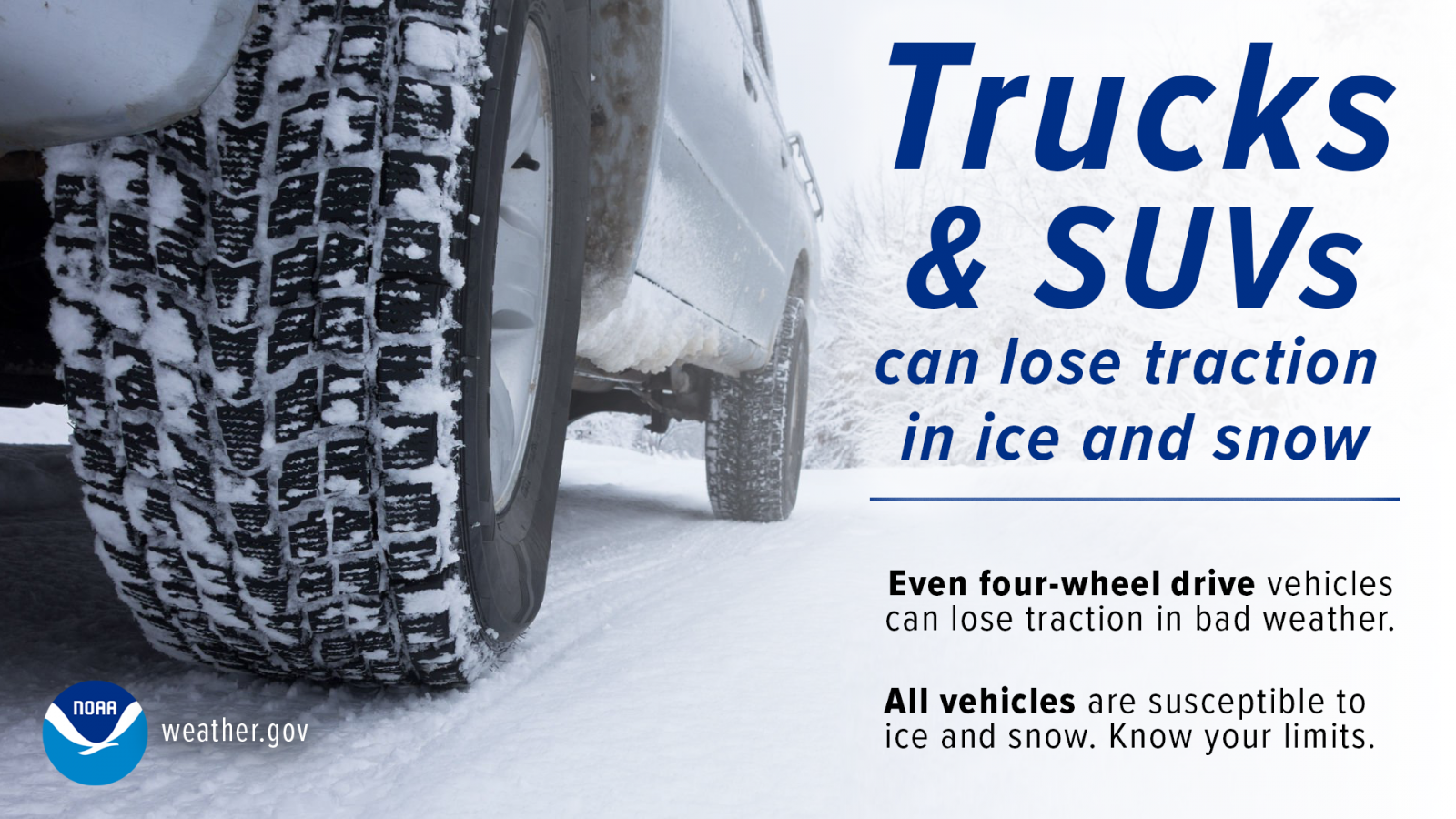
Facebook
Please thoroughly clean snow off your car — including the roof. Snow left on car roofs can fly off your vehicle when in motion, creating potentially dangerous situations for you and those driving behind you. Learn more winter safety tips at weather.gov/safety/winter
X
Please thoroughly clean snow off your car — including the roof. Snow left on car roofs can fly off your vehicle when in motion, creating potentially dangerous situations for you and those driving behind you. Learn more winter safety tips at weather.gov/safety/winter
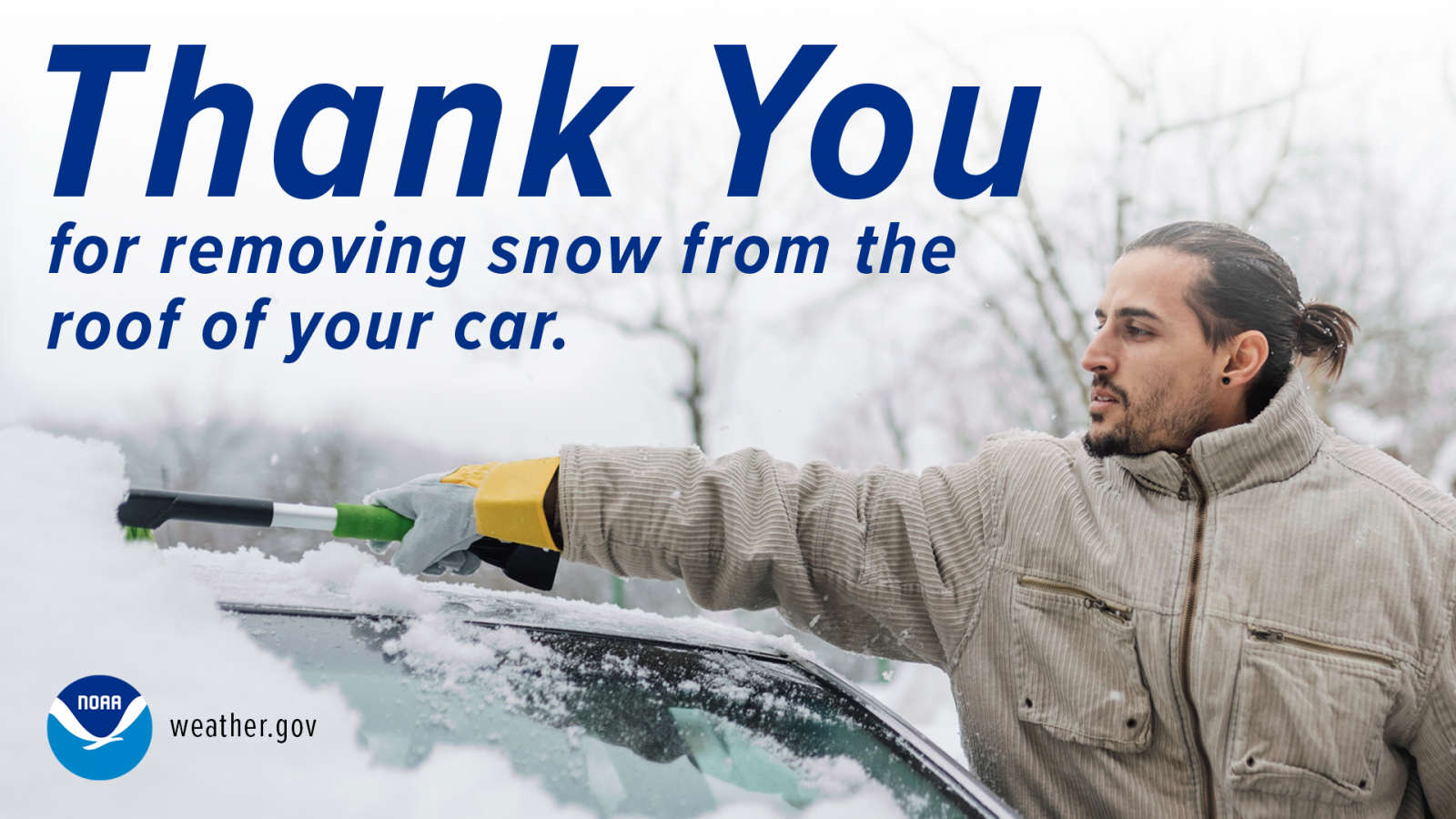
Facebook
Winter driving can be hazardous. Slow down to keep yourself and everyone on the road safe. Remember, “Ice and snow, take it slow”. Learn more at weather.gov/safety/winter
X
Do your part to keep everyone safe on the roads this winter. Learn more at weather.gov/safety/winter
#WeatherReady
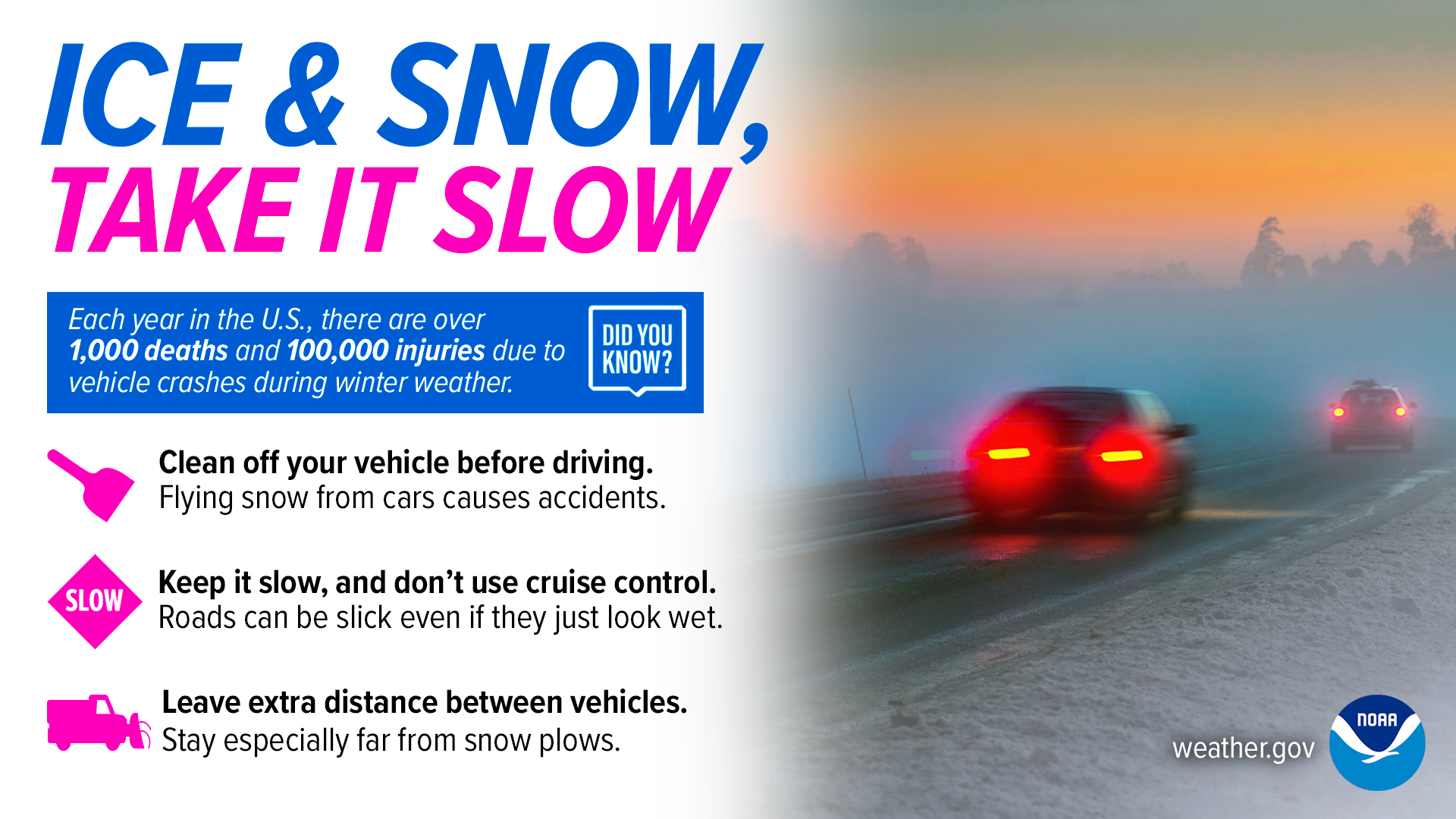
Facebook
Snow squalls are intense bursts of snow and wind with whiteout visibility that are extremely dangerous, especially while on the road. The National Weather Service helps you be ready by issuing Snow Squall Warnings that can trigger a Wireless Emergency Alert on your phone. If you receive one, know that a snow squall is occurring or imminent and slow down or delay travel. weather.gov/safety/winter-snow-squall
X
Snow squalls are extremely dangerous while on the road. NWS helps you be #WeatherReady by issuing Snow Squall Warnings that can trigger a Wireless Emergency Alert on your phone. When issued, slow down or delay travel. weather.gov/safety/winter-snow-squall
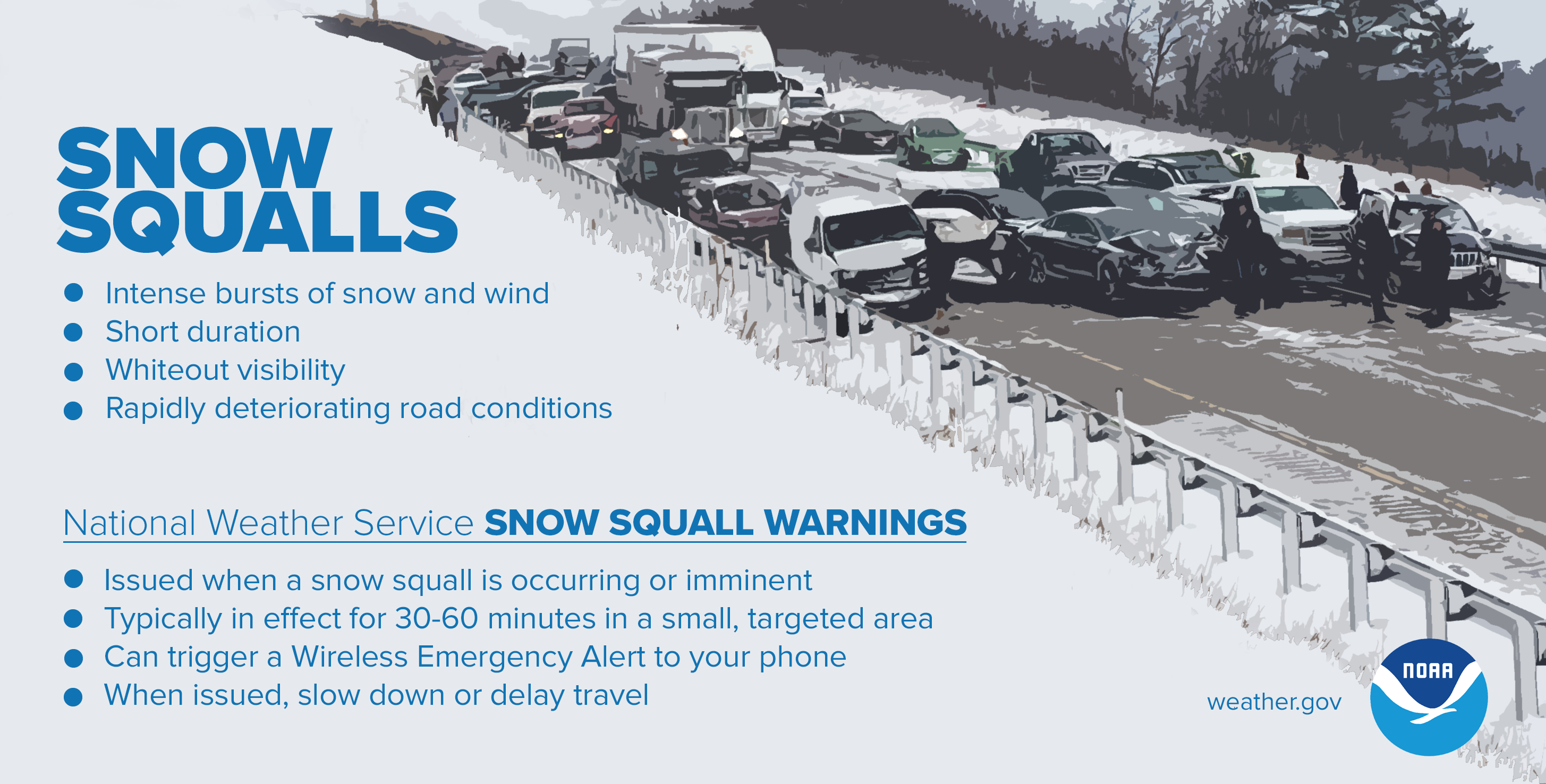
Facebook
During a snow squall, the last place you want to be is on the road.
Delay travel if a snow squall warning is issued. If you’re caught on the road when a snow squall occurs, use extreme caution. Slow down, turn on your low-beams and hazards, and pull over safely to the side of the road, remaining in the vehicle with the seatbelt on.
weather.gov/safety/winter-snow-squall
X
During a snow squall, the last place you want to be is on the road.
Stay #WeatherReady by delaying travel if there’s a snow squall warning.
If you’re caught on the road when a snow squall occurs, use extreme caution.
weather.gov/safety/winter-snow-squall
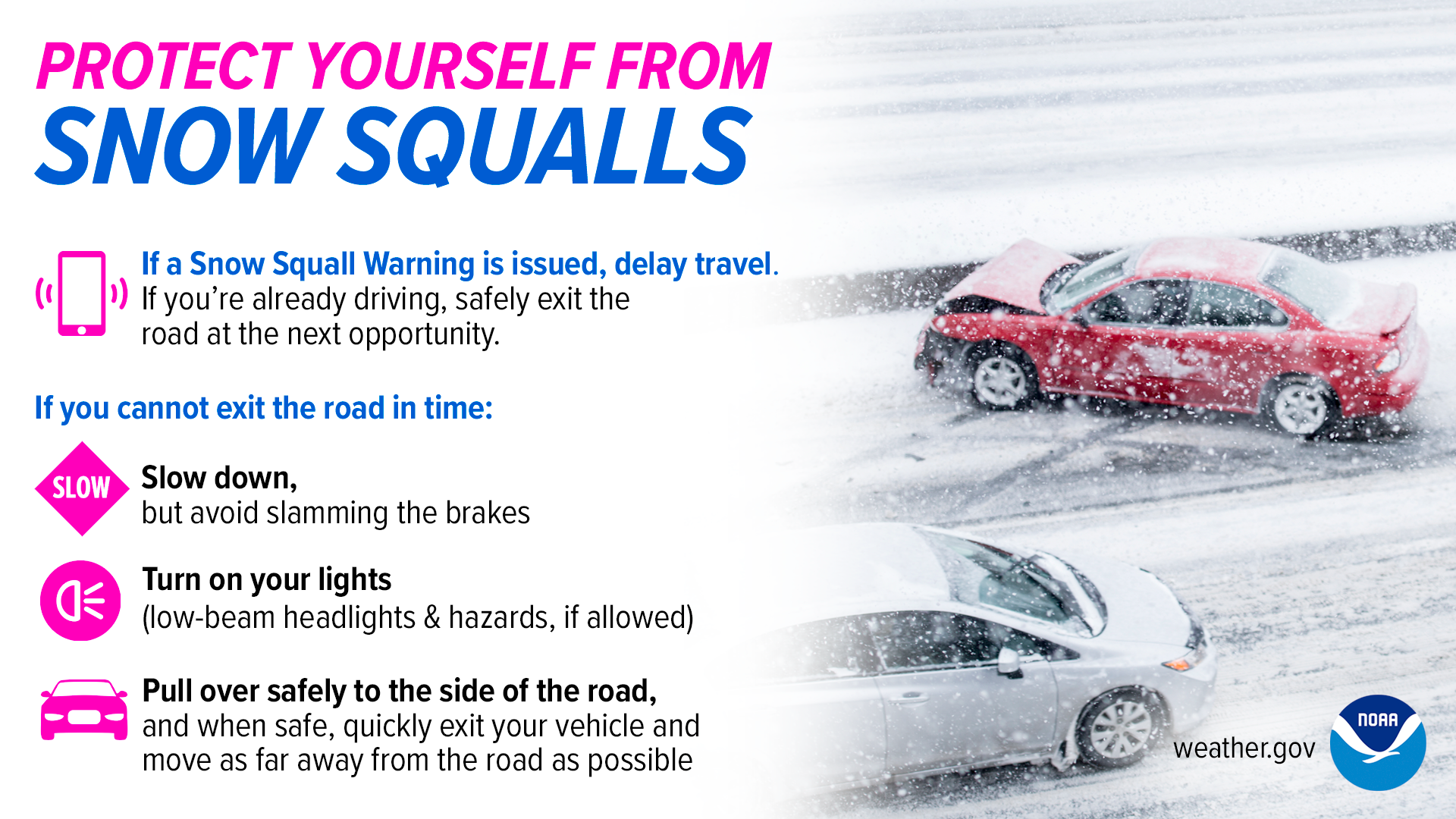
Facebook
You’ve probably seen road signs advising that bridges freeze before roads, but do you know why? Having open air underneath the bridge means the cold air surrounds the bridge both above and below. If there’s even the chance that a bridge might be frozen, SLOW DOWN! And do it before you cross the bridge — changing speed on ice is dangerous. weather.gov/safety/winter
X
You’ve probably seen road signs advising that bridges freeze before roads, but do you know why? Having open air underneath the bridge means the cold air surrounds the bridge both above and below. weather.gov/safety/winter #WeatherReady
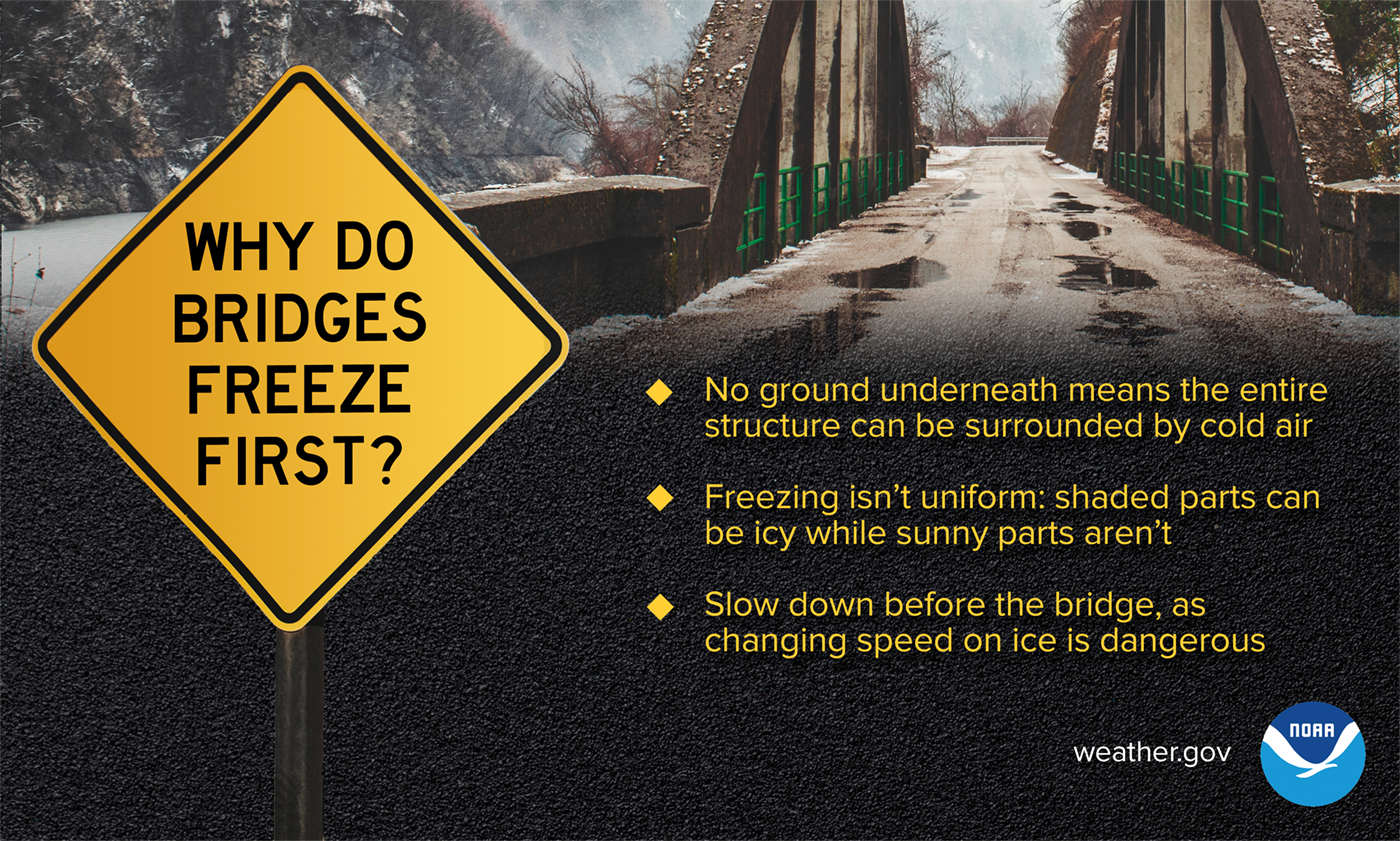
Facebook
Compared to a typical snowstorm, freezing rain is much more hazardous — especially on the road. While both are dangerous, it’s far easier to lose control of your vehicle on icy pavement, not to mention the increased risk of falling branches and powerlines. Bottom line: use extreme caution if there is, or recently was, freezing rain. weather.gov/safety/winter
X
Compared to a typical snowstorm, freezing rain is much more hazardous — especially on the road. Bottom line: be #WeatherReady and use extreme caution if there is, or recently was, freezing rain. weather.gov/safety/winter
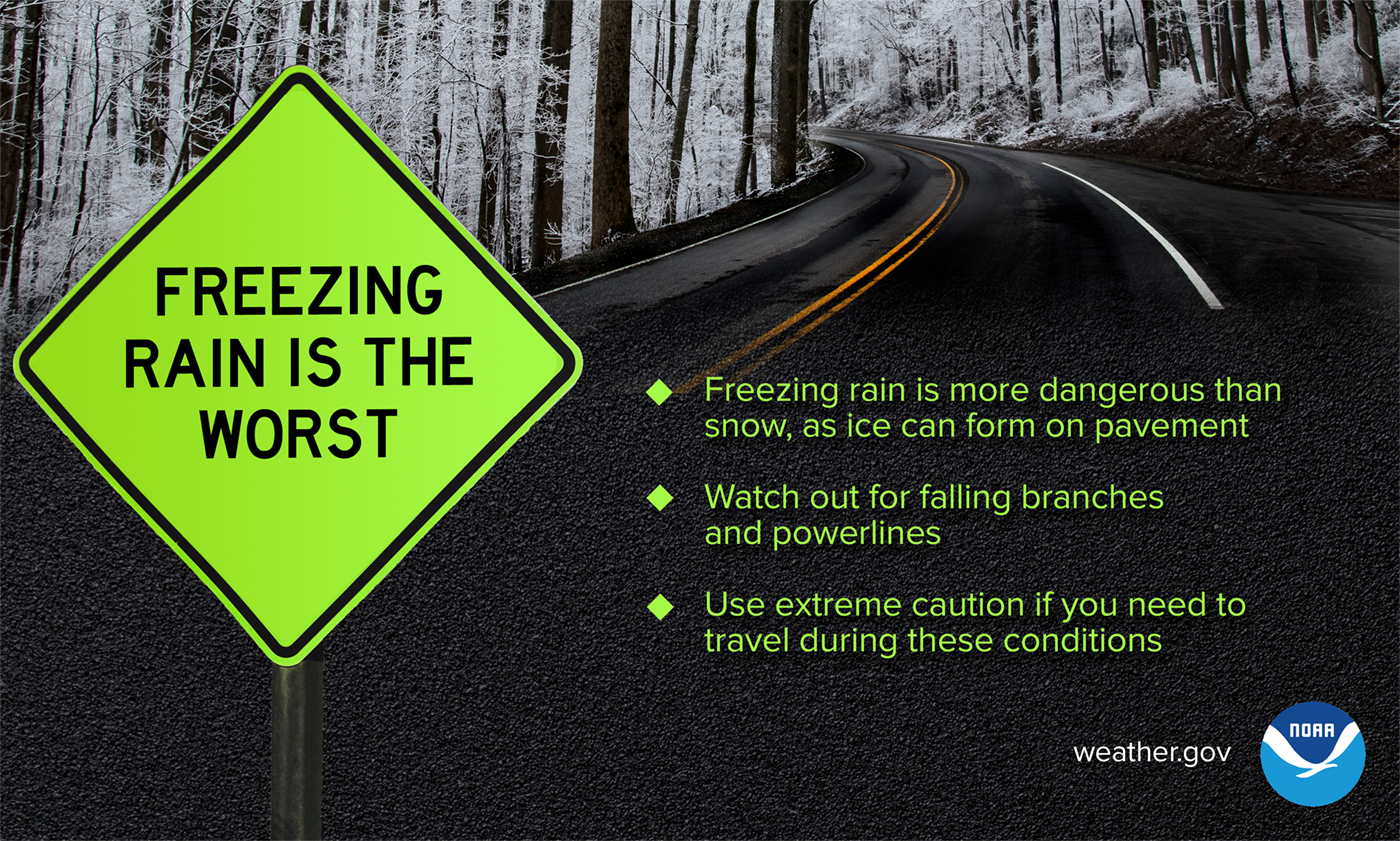
Facebook
When recent rain or snowmelt comes into contact with freezing temperatures, black ice can form — and you might not even see it. While black ice is more prevalent at night, it can often stick around for the morning commute. Use caution when driving...don’t let black ice sneak up on you. weather.gov/safety/winter
X
Don’t let black ice sneak up on you! When recent rain or snowmelt comes into contact with freezing temperatures, black ice can form — and you might not even see it. weather.gov/safety/winter #WeatherReady
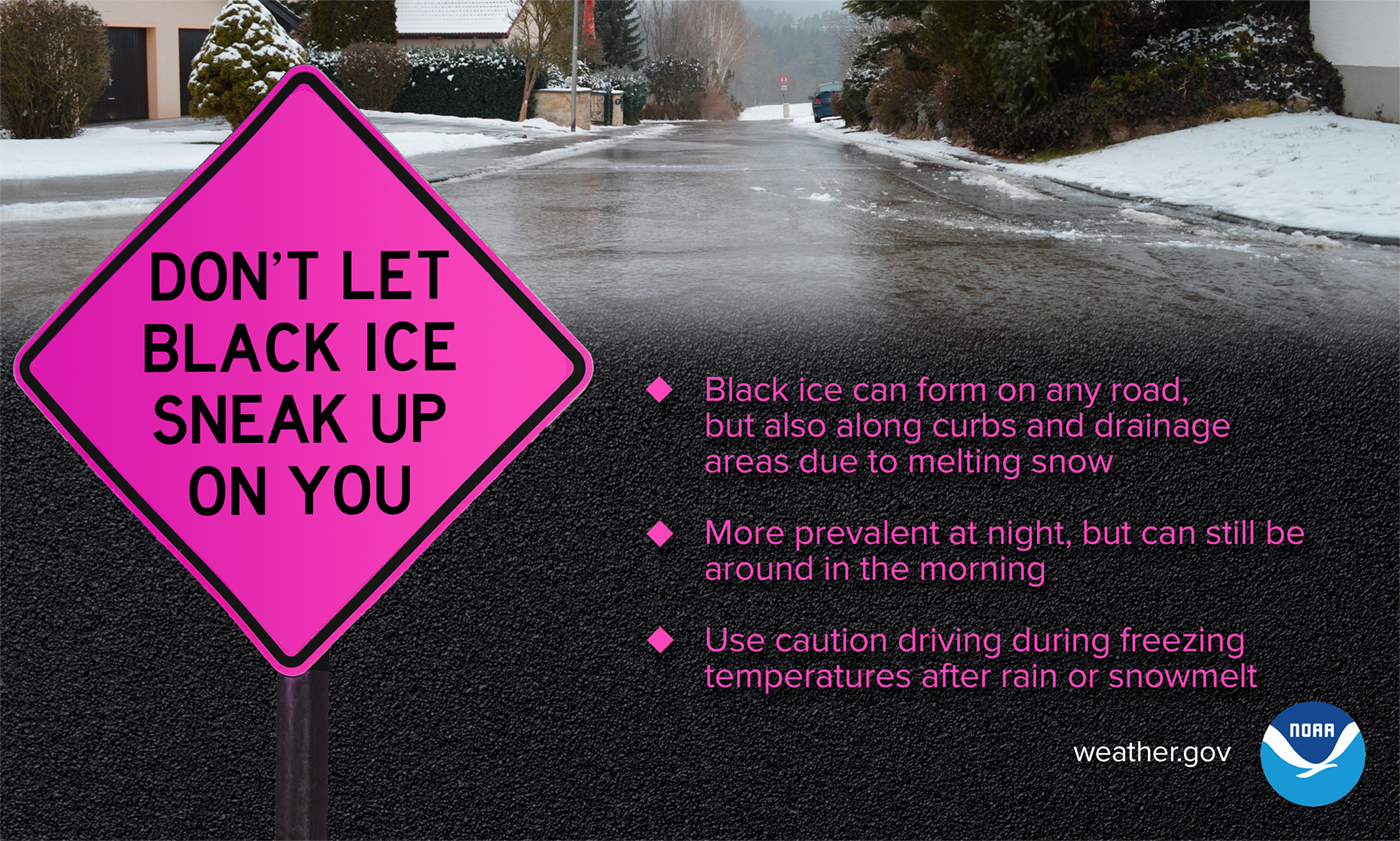
Facebook
While lots of snow in the middle of winter can certainly cause dangerous travel conditions, many times it’s the first snow of the season that can cause accidents. Be extra careful as you and other drivers adjust to driving in poor conditions. Slow down, don’t use cruise control, and keep your distance from other vehicles. Don’t let the first snow sneak up on you!
X
While lots of snow in the middle of winter can cause dangerous travel conditions, the first snow of the season can also cause accidents. Be careful as you and other drivers adjust to driving in poor conditions. Don’t let the first snow sneak up on you! #WeatherReady
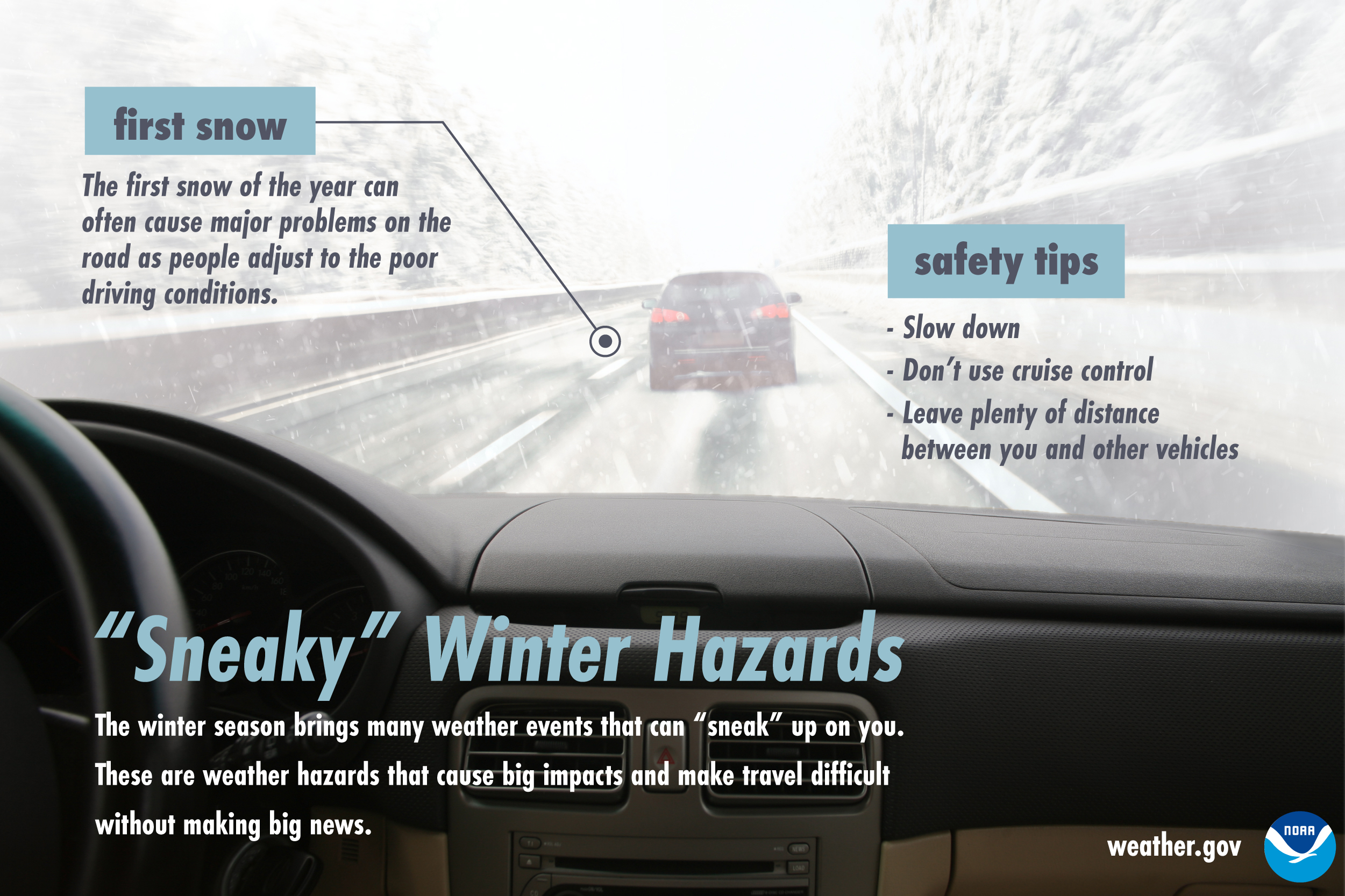
Facebook
Even on a nice winter day, the low sun angle can make driving hazardous. Freshly-fallen snow can add more glare to your drive. Have a pair of sunglasses on hand, slow down, and leave plenty of distance between you and other vehicles. Don’t let sun glare sneak up on you!
X
The low sun angle, especially combined with freshly-fallen snow, can cause a glare that makes driving difficult. Keep a pair of sunglasses handy and slow down. Don’t let sun glare sneak up on you! #WeatherReady
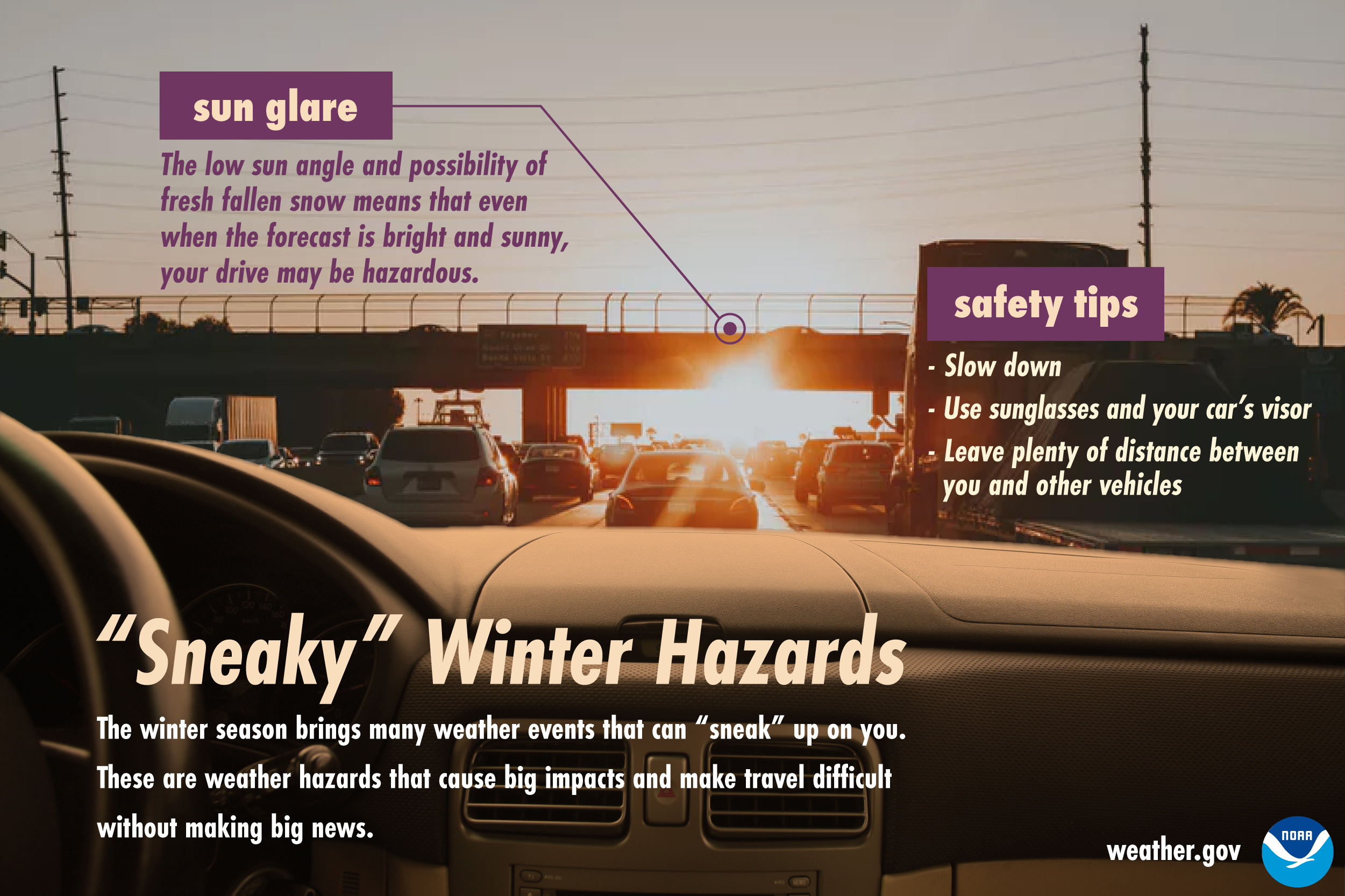
Facebook
Rain may seem like less of a winter driving hazard than snow, but when temperatures are near freezing, that’s not the case. Ice can form quickly and make roads slick. In these conditions, slow down, don’t use cruise control, and keep plenty of distance between you and other vehicles. Don’t let this winter hazard sneak up on you!
X
Rain may seem like less of a winter driving hazard than snow, but when temperatures are near freezing, that’s not the case. Ice can form quickly and make roads slick. Be extra careful in these conditions and don’t let this winter hazard sneak up on you! #WeatherReady
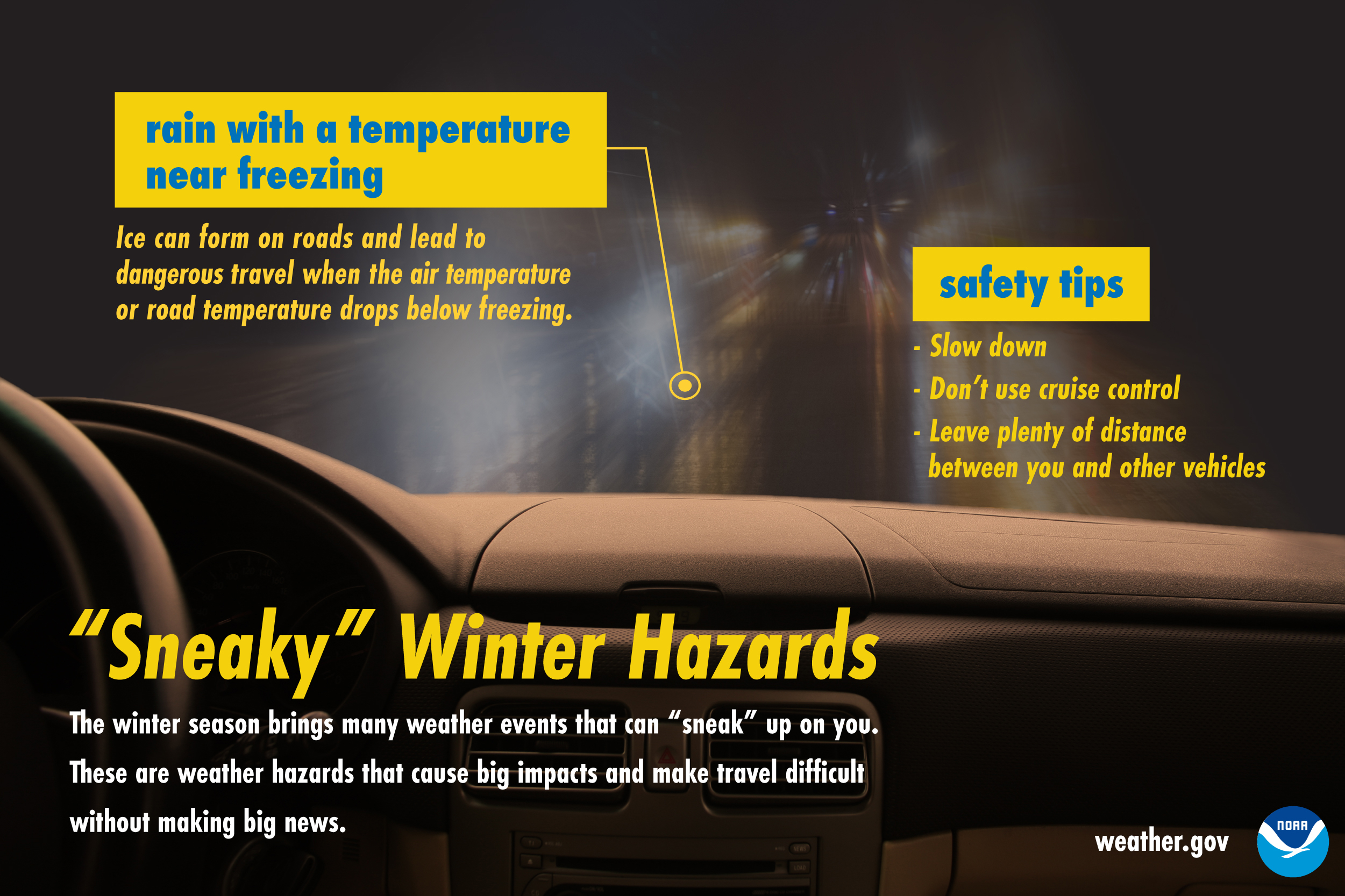
Facebook
When surface temperatures are below freezing, drizzle will form a thin layer of ice on the roads. This difficult-to-see ice can cause very dangerous travel conditions. When it’s drizzling in the winter, slow down, don’t use cruise control, and keep your distance from other vehicles. Don’t let freezing drizzle sneak up on you!
X
Freezing drizzle can cause difficult-to-see ice to form on roads, creating very dangerous travel conditions. When it’s drizzling in the winter, slow down! Don’t let freezing drizzle sneak up on you. #WeatherReady
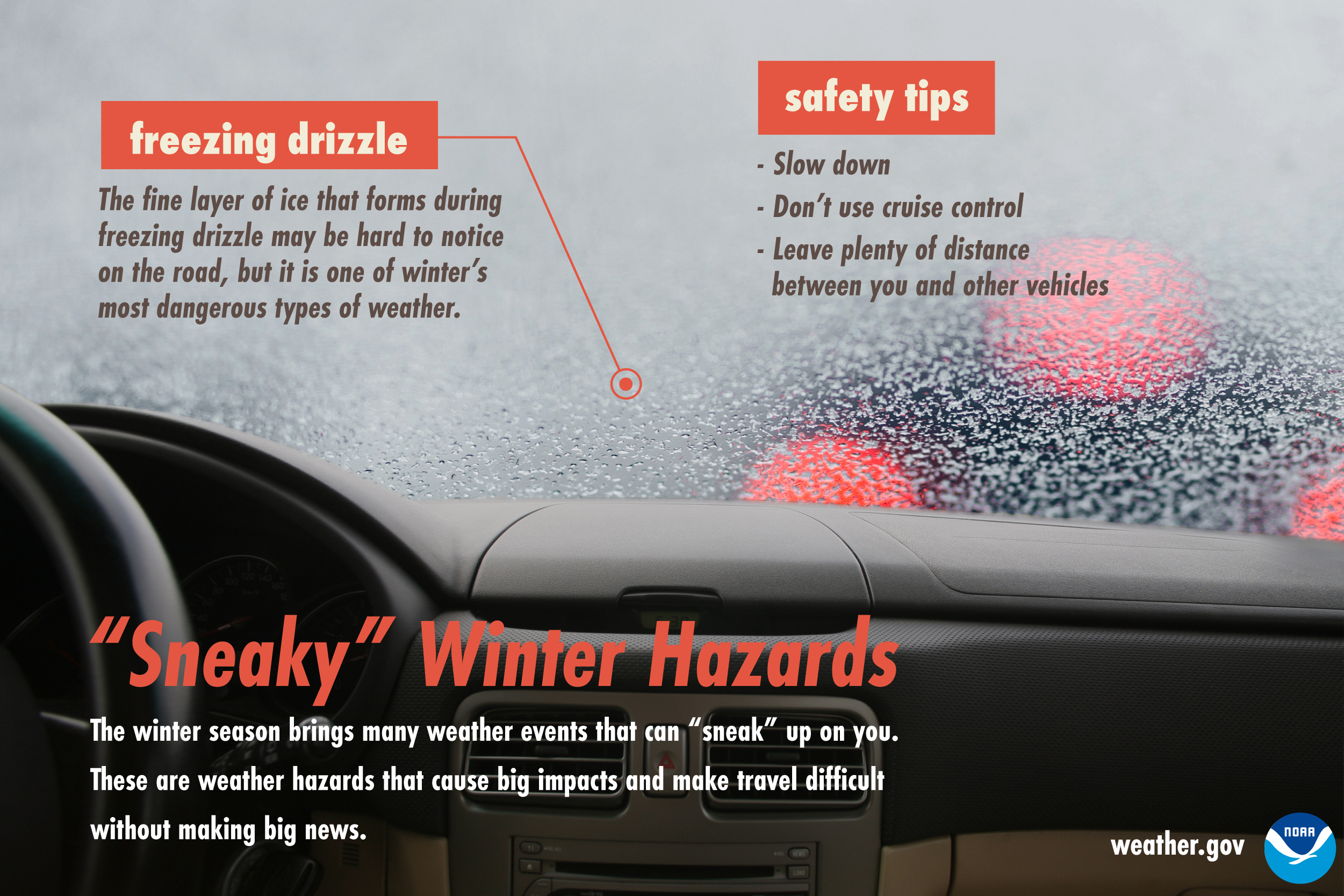
Facebook
Even when it’s not precipitating, wet roads can quickly turn icy as temperatures dip below freezing. These unexpected slippery conditions can make driving hazardous. When roads look wet in the winter, stay cautious, slow down, and don’t use cruise control. Don’t let flash freezes sneak up on you!
X
Wet roads can quickly turn to ice as temperatures fall below freezing. Slow down and don’t use cruise control. Don’t let flash freezes sneak up on you! #WeatherReady
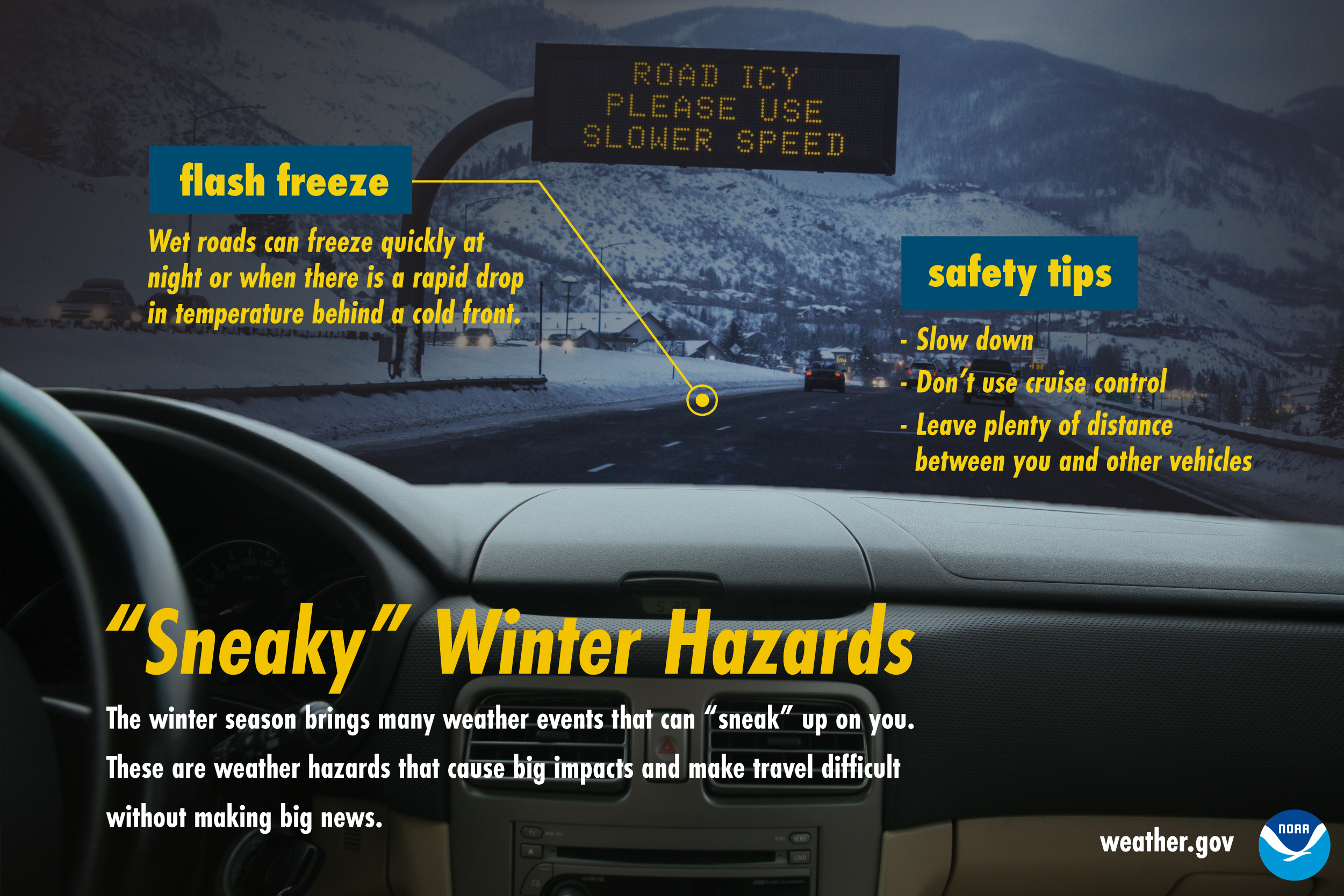
Facebook
You wouldn’t think a little bit of rain could make the roads slippery, but after a long dry stretch, it can happen. This is because oil and debris accumulate on the road during the dry period. Once the rain starts falling, roads become slick. Slow down in these situations–this is one of those hazards that can sneak up on you!
X
When it rains after a long dry stretch, roads can become surprisingly slippery. Don’t let this hazard sneak up on you! Slow down and don’t use cruise control. #WeatherReady
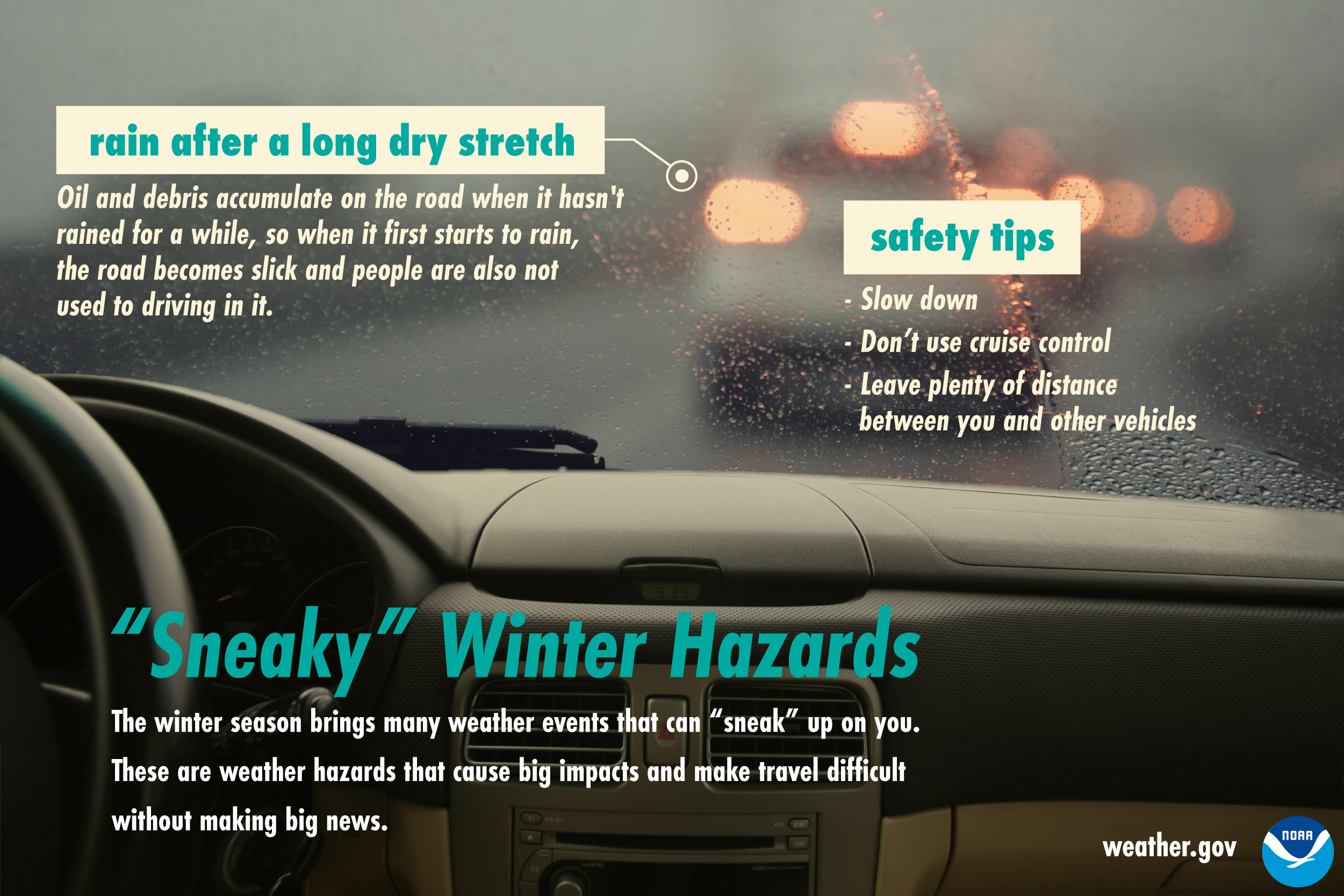
Facebook
Visibility can change quickly in fog, creating hazardous driving conditions. Slow down, use your low-beam headlights, and leave plenty of distance between you and other vehicles. Don’t let fog sneak up on you!
X
Watch out for quickly-changing visibility in fog. Use your low-beam headlights, slow down, and keep your distance from other vehicles. Don’t let fog sneak up on you! #WeatherReady
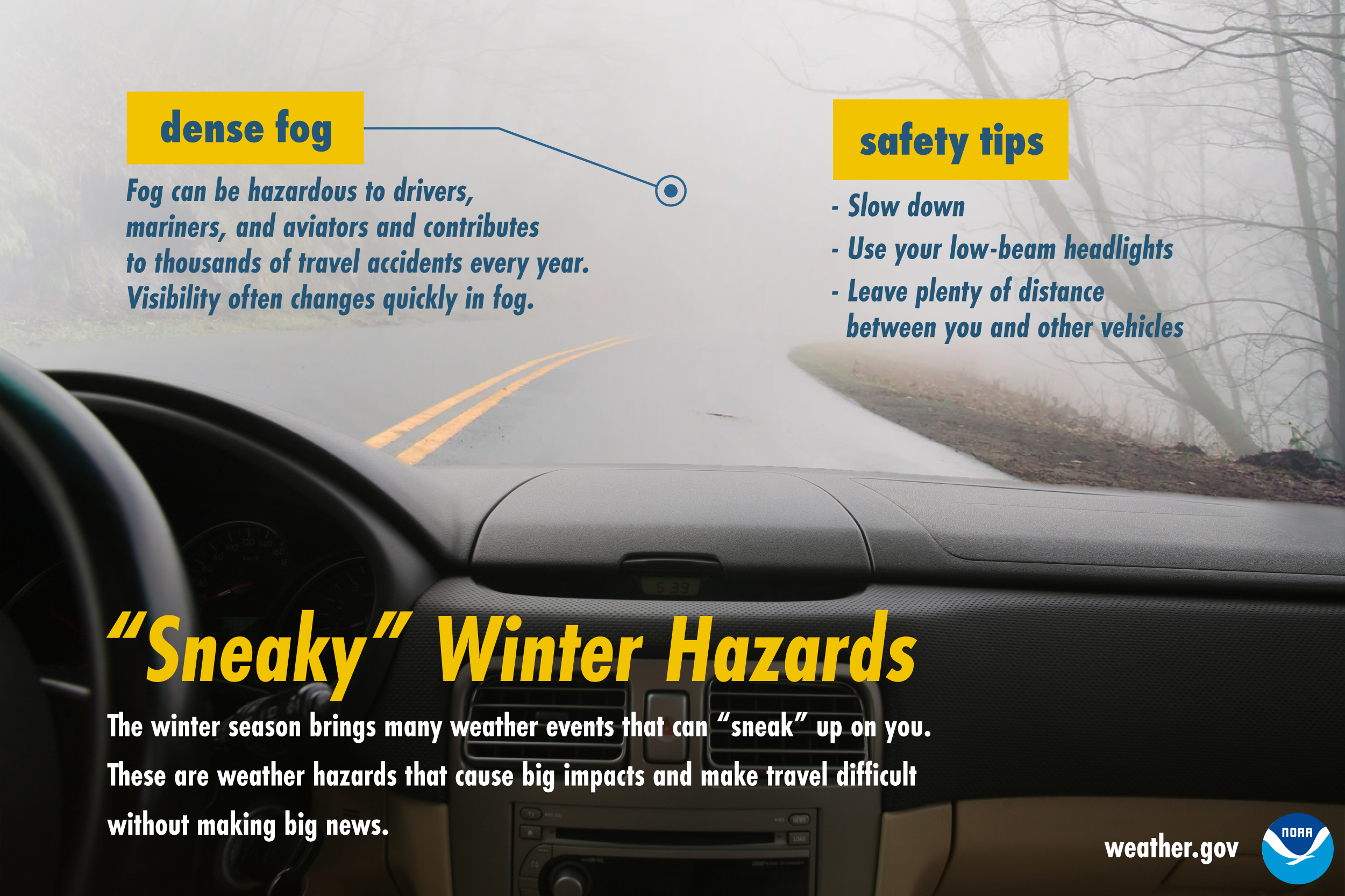
Facebook
Snow squalls are short, intense bursts of snow and wind that can catch people off guard. They can reduce visibility and cause dangerous travel conditions. If possible, avoid or delay travel until the squall passes. If you’re caught in one, slow down, turn on your headlights and hazard lights, and try to exit the road. Don’t let snow squalls sneak up on you!
X
Snow squalls are short, intense bursts of snow and wind that can reduce visibility and cause dangerous travel conditions. Delay travel if possible.. Don’t let snow squalls sneak up on you! #WeatherReady
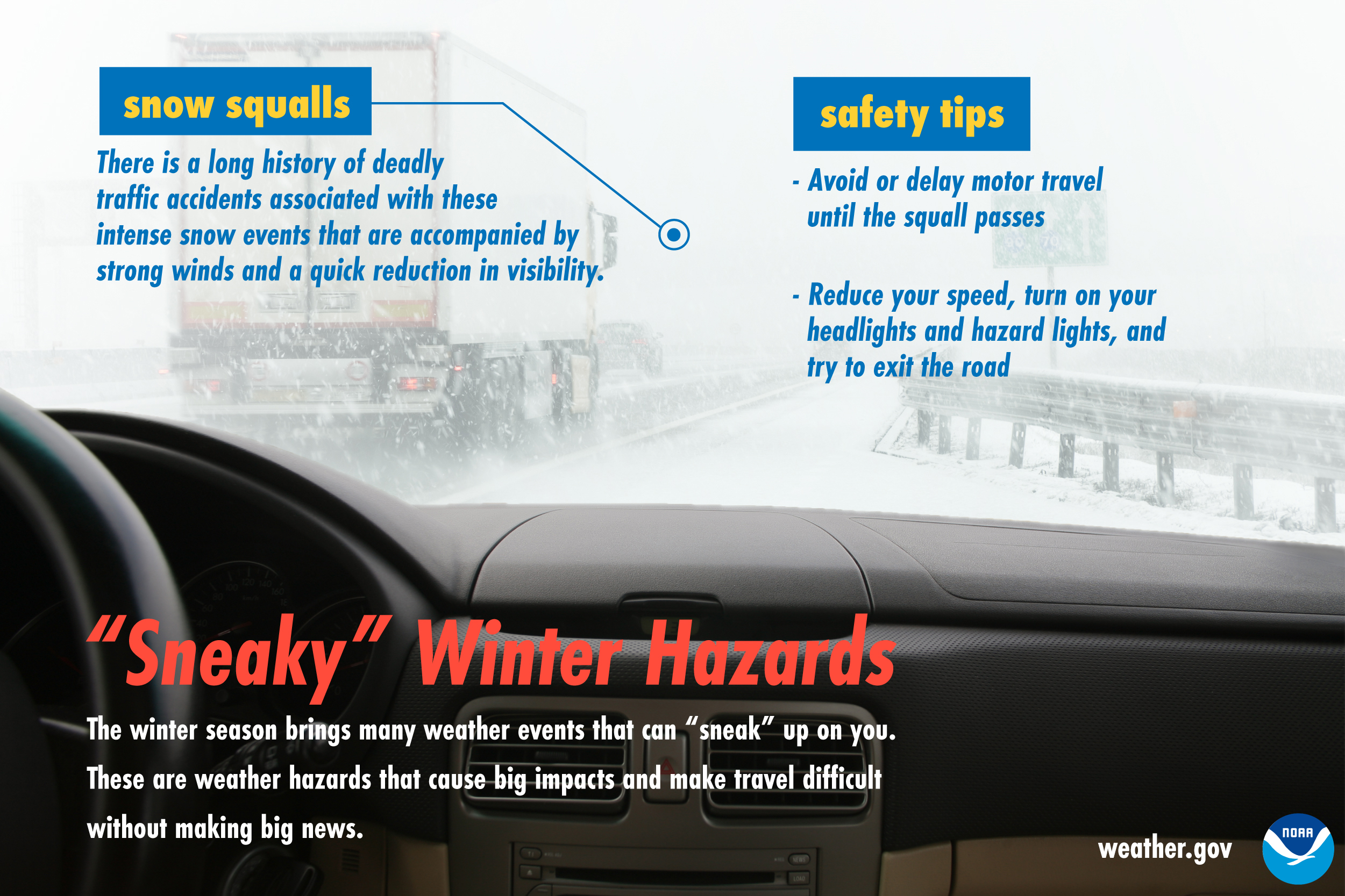
Facebook
Avalanches can pose a very real danger to drivers on mountain roads. If you are caught in an avalanche, stay in your vehicle and turn off the engine to avoid carbon monoxide poisoning from a clogged tailpipe. Avoid danger in the first place by heeding warning signs and not driving around barriers - and be Weather-Ready by equipping your car with an emergency kit. weather.gov/safety/winter-avalanche
X
Avalanches can pose a very real danger to drivers on mountain roads. If you are caught in an avalanche, stay in your vehicle and turn off the engine to avoid carbon monoxide poisoning from a clogged tailpipe. weather.gov/safety/winter-avalanche
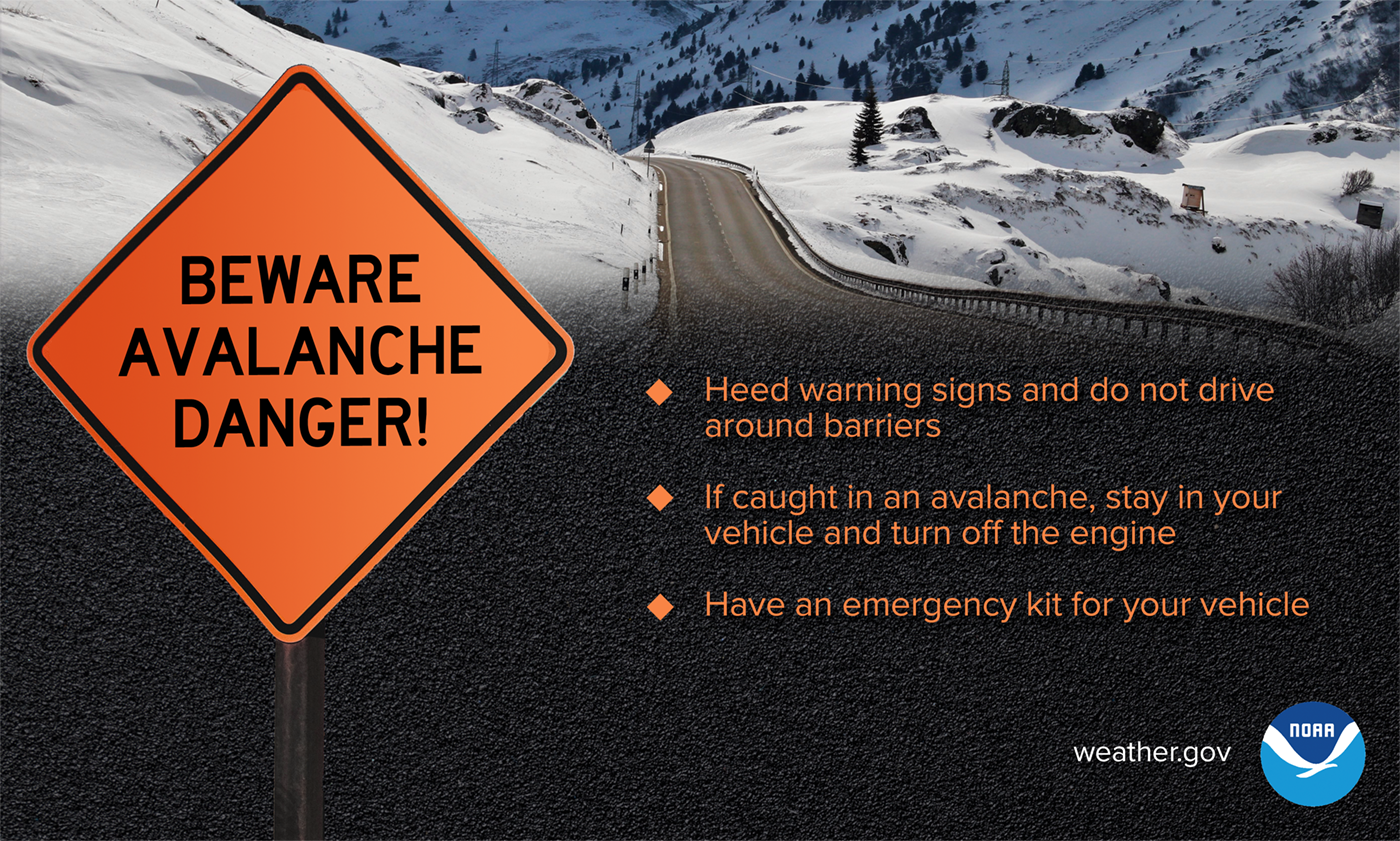
Recreation and Environment
Facebook
Ice is never completely safe. Know how thick the ice is and stay away from any cracks or melting ice. If you don’t know, don’t go! weather.gov/safety/winter
X
Ice is never completely safe. Know how thick the ice is and stay away from any cracks or melting ice. If you don’t know, don’t go! weather.gov/safety/winter #WeatherReady

Facebook
Ice jams are common during the winter and spring along rivers, streams, and creeks in the higher latitudes of the continental U.S. as well as in Alaska. Once formed, water can rise VERY quickly. Stay Weather-Ready and never cross flooded roads. weather.gov/safety/flood-hazards
X
Ice jams are common during the winter and spring along rivers, streams, and creeks in the higher latitudes of the continental U.S. as well as in Alaska. Once formed, water can rise VERY quickly. Stay #WeatherReady and never cross flooded roads. weather.gov/safety/flood-hazards
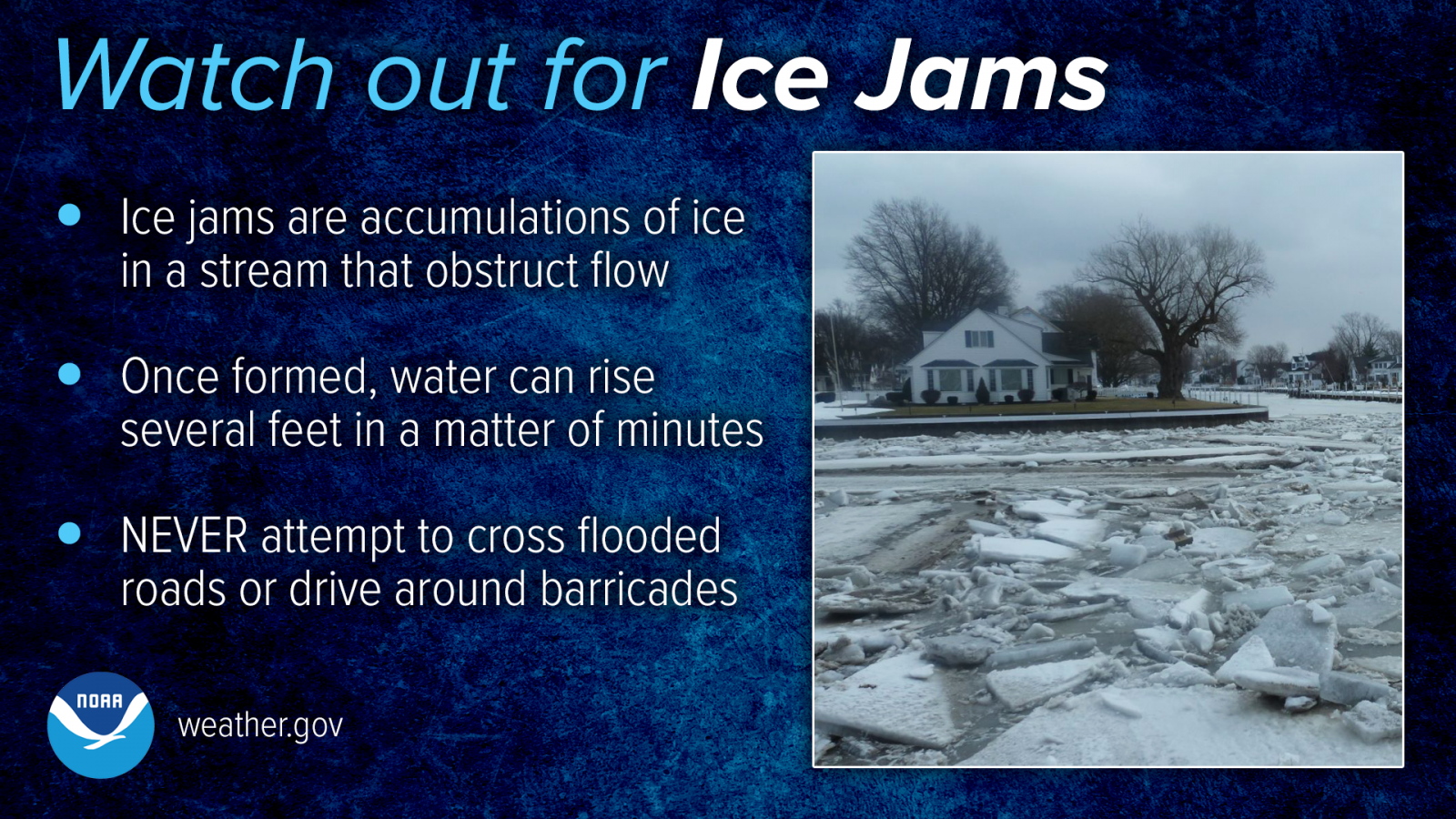
Facebook
Facebook: 98% of fatal avalanches are triggered by someone in the victim’s party. Learn how to safely plan your visit to the backcountry by visiting avalanche.org.
X
98% of fatal avalanches are triggered by someone in the victim’s party. Learn how to safely plan your visit to the backcountry by visiting avalanche.org.
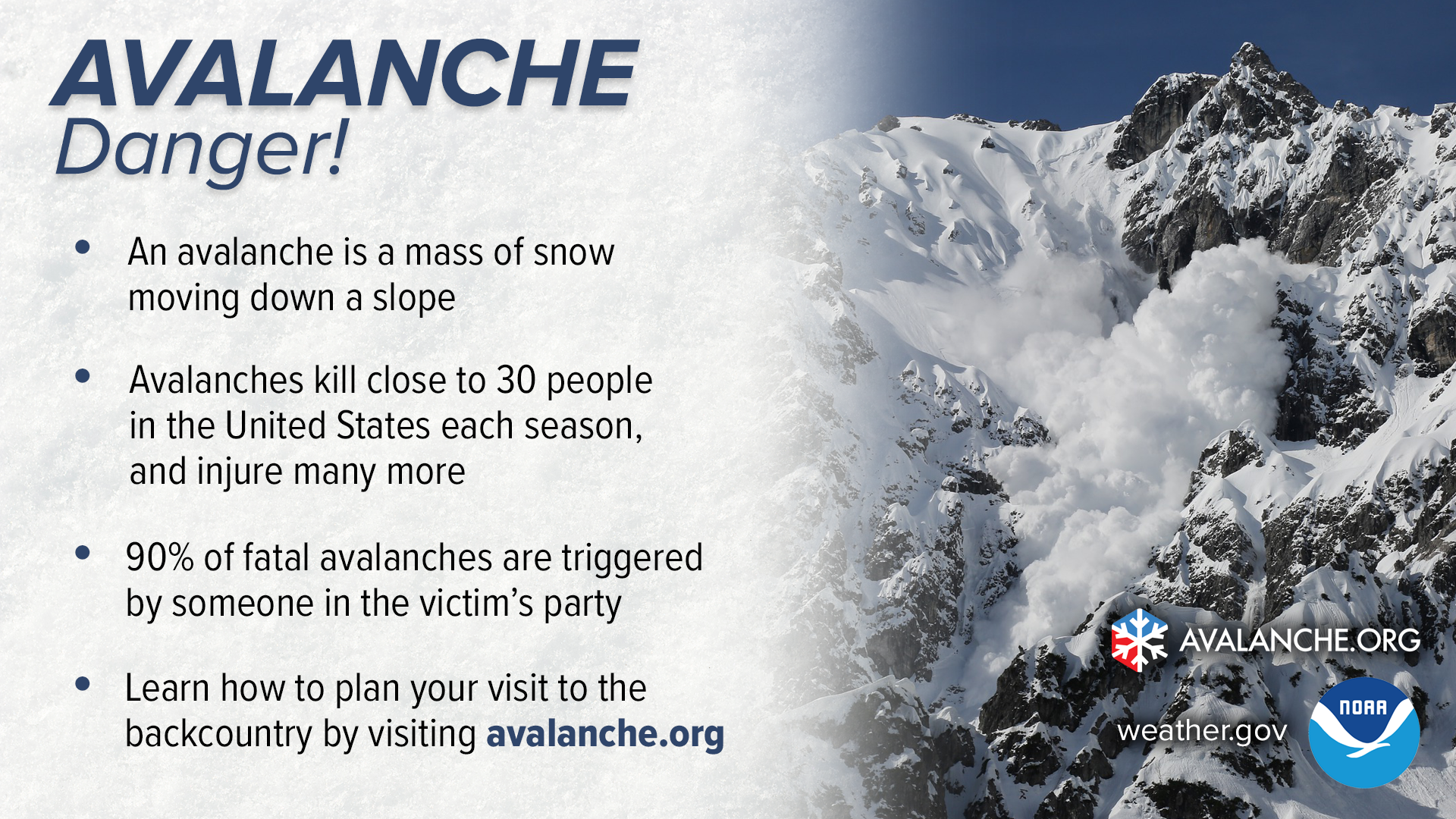
Facebook
If you’re heading on a trip to the backcountry, it’s important to be prepared for the possibility of an avalanche. Make sure to have an updated forecast and get the correct gear to help keep you and your party safe. www.avalanche.org
X
If you’re heading on a trip to the backcountry, it’s important to be prepared for the possibility of an avalanche. Make sure to have an updated forecast and get the correct gear to help keep you and your party safe. www.avalanche.org
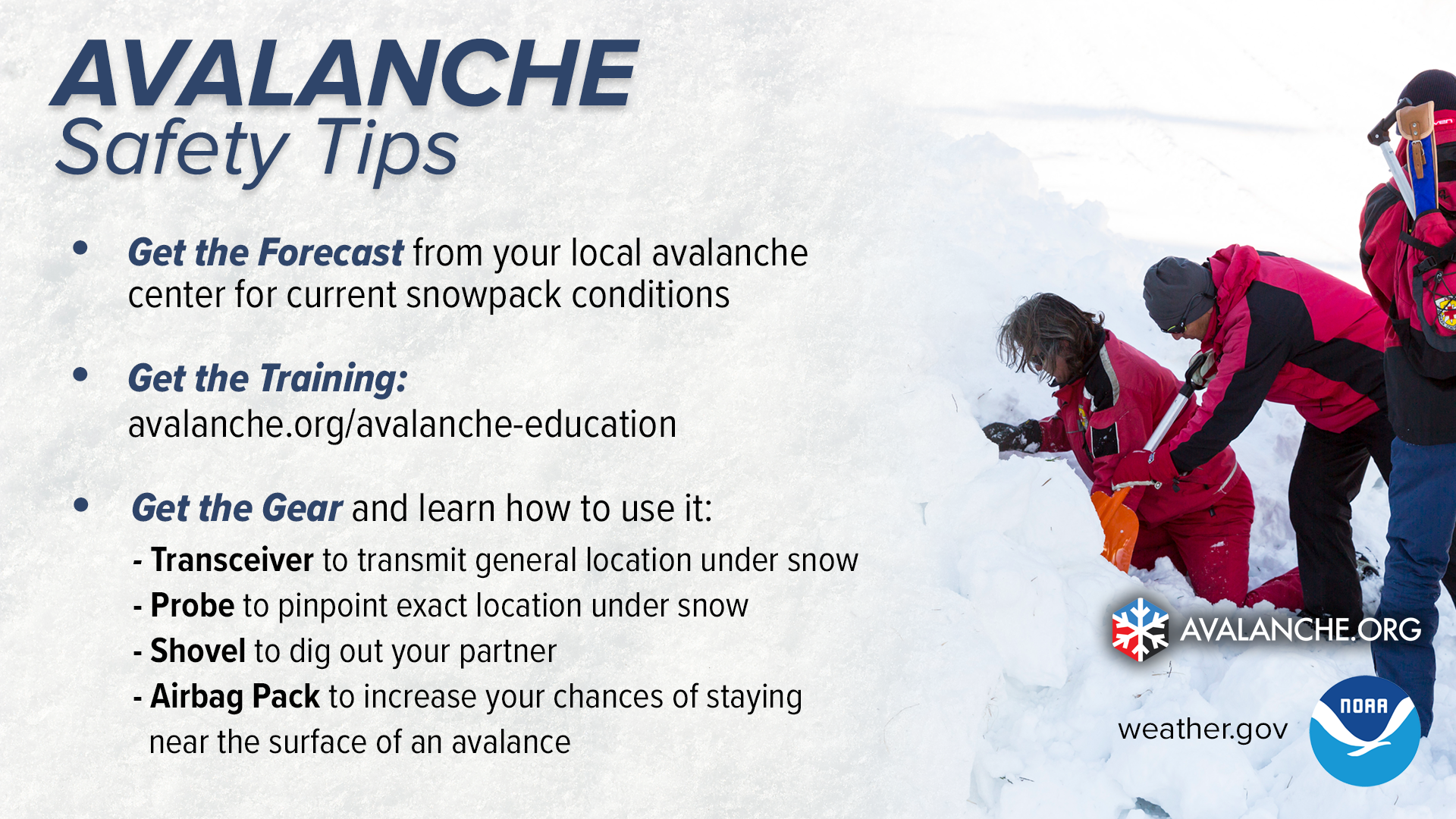
Facebook
There are many warning signs that indicate that an avalanche may occur. If you see any of these warning signs, leave or avoid potential avalanche terrain. www.avalanche.org
X
There are many warning signs that indicate that an avalanche may occur. If you see any of these warning signs, leave or avoid potential avalanche terrain. www.avalanche.org
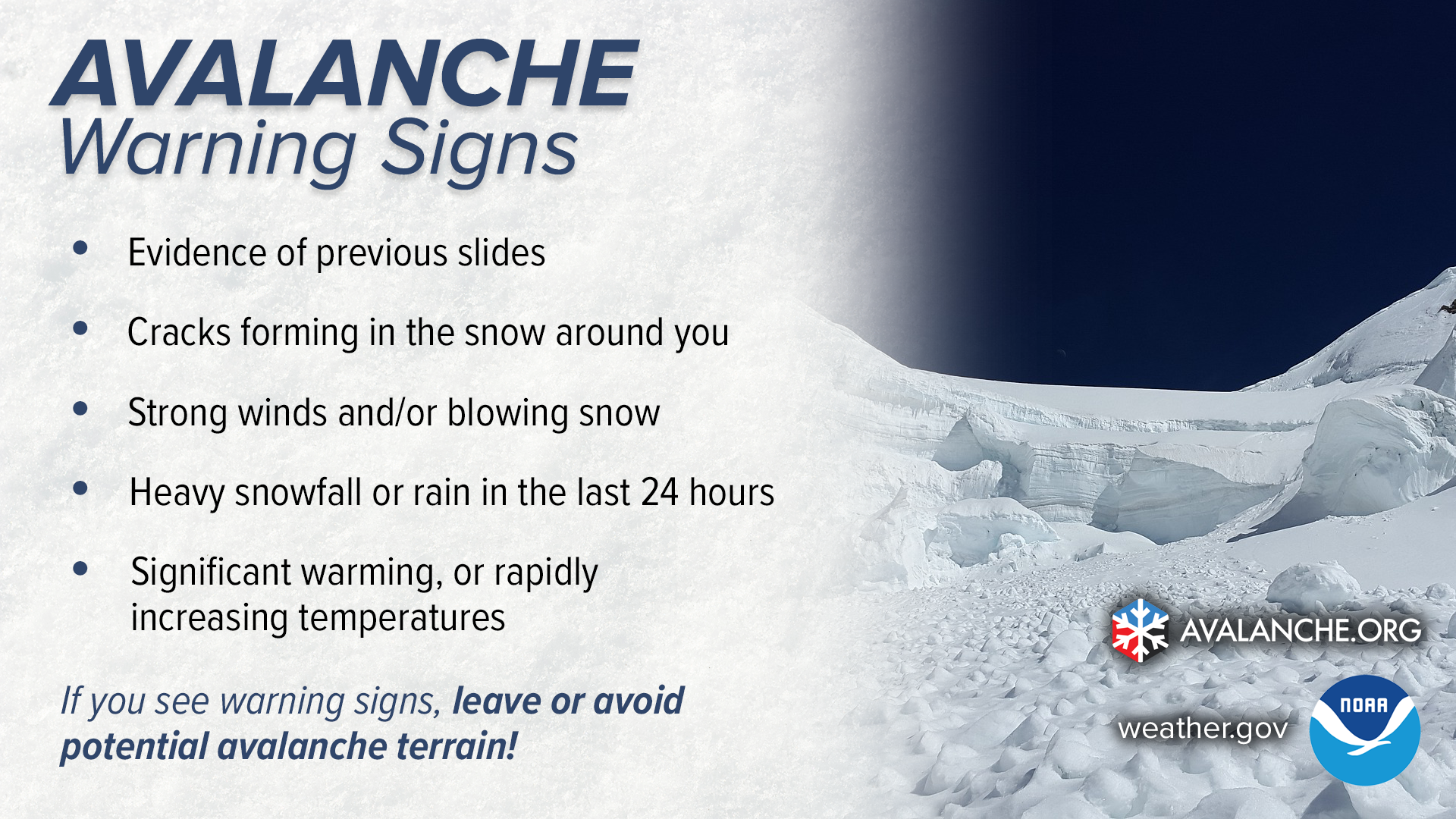
Facebook
Wearing a life jacket significantly increases chances of survival during an unexpected immersion into cold water. www.weather.gov/safety/coldwater
X
Wearing a life jacket significantly increases chances of survival during an unexpected immersion into cold water. www.weather.gov/safety/coldwater #WeatherReady
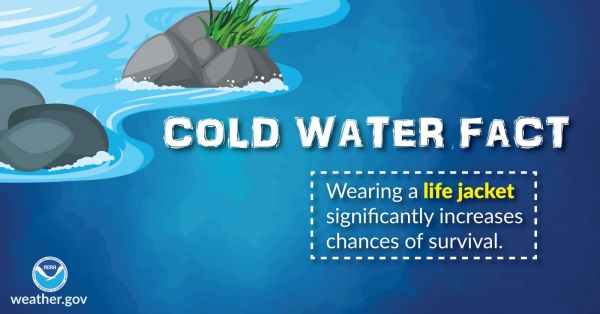
Facebook
Even strong swimmers face danger in cold water.www.weather.gov/safety/coldwater
X
Even strong swimmers face danger in cold water. www.weather.gov/safety/coldwater #WeatherReady
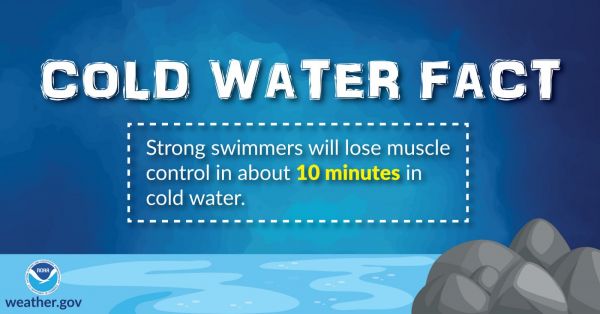
Facebook
Planning an outing on cold water? Be prepared for the possibility of sudden immersion into cold water, even if the air is warm. Cold water can kill.www.weather.gov/safety/coldwater
X
Planning an outing on cold water? Be prepared for the possibility of sudden immersion into cold water, even if the air is warm. Cold water can kill.www.weather.gov/safety/coldwater #WeatherReady

Science
Facebook
Extremely cold air affects millions of people across the United States every winter and even into parts of the spring. This Arctic air, together with brisk winds, can lead to dangerously cold wind chill values, which can cause your body to lose heat quickly. weather.gov/safety/cold-wind-chill-chart
X
Arctic air, together with brisk winds, can lead to dangerously cold wind chill values. weather.gov/safety/cold-wind-chill-chart

Facebook
Will there be rain, ice, or snow? This graphic explains how having different layers of warm and cold air between the clouds and the ground determines the type of precipitation that hits the ground. nssl.noaa.gov/education/svrwx101/winter/types/
X
Will there be rain, ice, or snow? Find out how wintry precipitation forms! nssl.noaa.gov/education/svrwx101/winter/types/

Facebook
Kona lows” are major weather producers in the Hawaiian islands. The word ‘kona’ means ‘leeward’ in Hawaiian, which refers to the side of an island that is usually sheltered from trade winds and rainfall—but not for these storms.
Learn more weather science at weather.gov/jetstream
X
“Kona lows” are major weather producers in the Hawaiian islands. The word ‘kona’ means ‘leeward’ in Hawaiian, which refers to the side of an island that is usually sheltered from trade winds and rainfall—but not for these storms.
Learn more weather science at weather.gov/jetstream
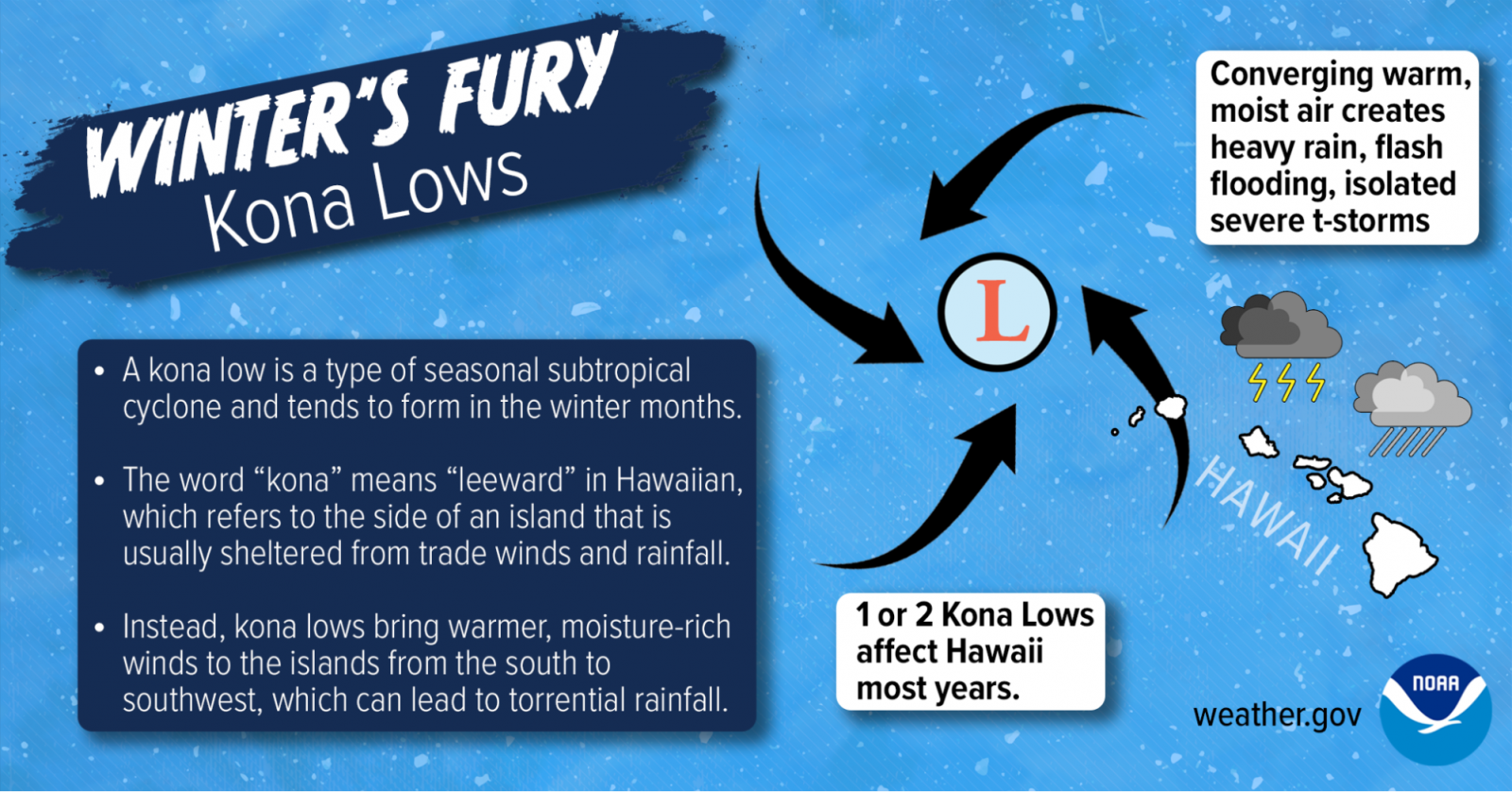
Facebook
Not many winter storms have the potential to bury 100 million people in 1-2 feet of snow in a single day. Nor’easters are notorious for packing strong winds and copious amounts of moisture they get from the Atlantic. The heavily-populated region between Washington D.C., Philadelphia, New York City, and Boston -- the “I-95 Corridor” -- is especially impacted by Nor’easters. weather.gov/safety/winter-noreaster
X
Nor’easters are notorious for big wind and copious amounts of moisture they get from the Atlantic. weather.gov/safety/winter-noreaster #WeatherReady

Facebook
Did you know not all blizzards involve falling snow? By definition, a blizzard includes 35+ mph winds that cause blowing snow, reducing visibility to 1/4 mile or less for at least 3 hours. If the visibility reduction comes from snow that has already fallen, it is called a ground blizzard. Whether or not the snow falls during the time of the blizzard, dangerous conditions can result. Make sure you’re prepared! weather.gov/winter
X
Did you know that not all blizzards involve falling snow? Whether or not the snow falls during the blizzard, dangerous conditions can result. weather.gov/winter Be #WeatherReady!
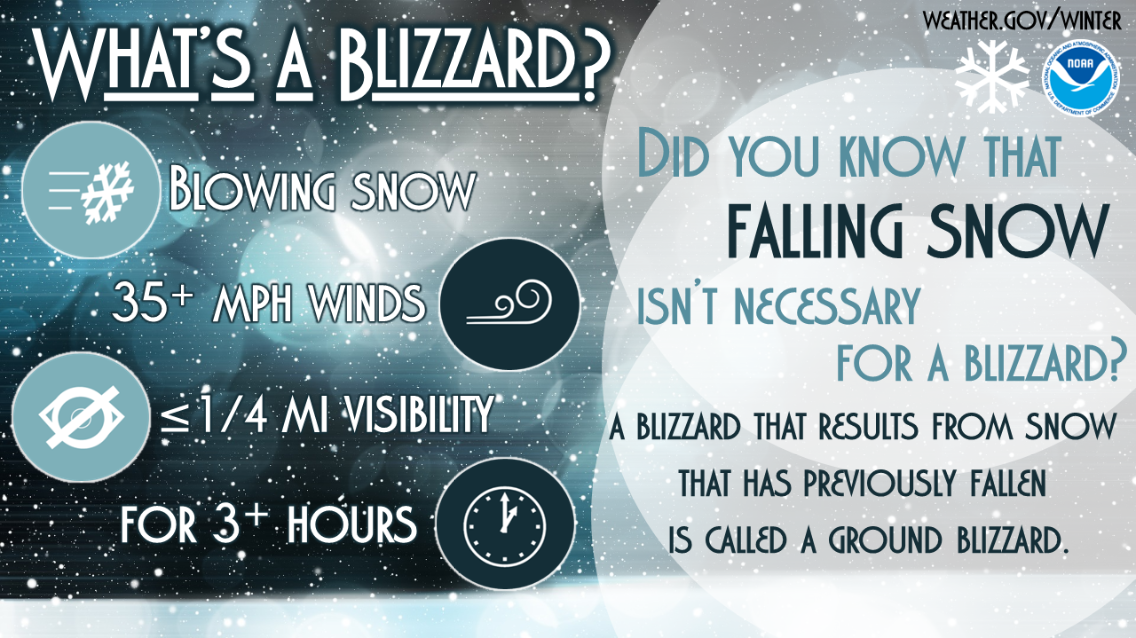
Facebook
Lake Effect snow occurs when cold air moves across warmer water. Warmth and moisture rise into the air, condensing into clouds that can produce 2 to 3 inches of snow per hour or more. Learn more weather science at weather.gov/jetstream
X
Lake Effect snow occurs when cold air moves across warmer water. Warmth and moisture rise into the air, condensing into clouds that can produce 2 to 3 inches of snow per hour or more. Learn more weather science at weather.gov/jetstream

Facebook
Have you wondered why the windward side of mountains or large hills receives so much more snow than surrounding areas? This is due to upslope snow. When moist wind blows against the side of mountains/hills, the air is forced to rise (called orographic lift). As the air rises and cools, water vapor condenses, resulting in clouds and precipitation over the windward region. Conversely, the leeward side often receives less snow due to descending air.
X
Why does the windward side of mountains or large hills receive so much more snow than surrounding areas? It’s because of the upslope effect. When you’re in one of these windward areas, make sure you’re #WeatherReady
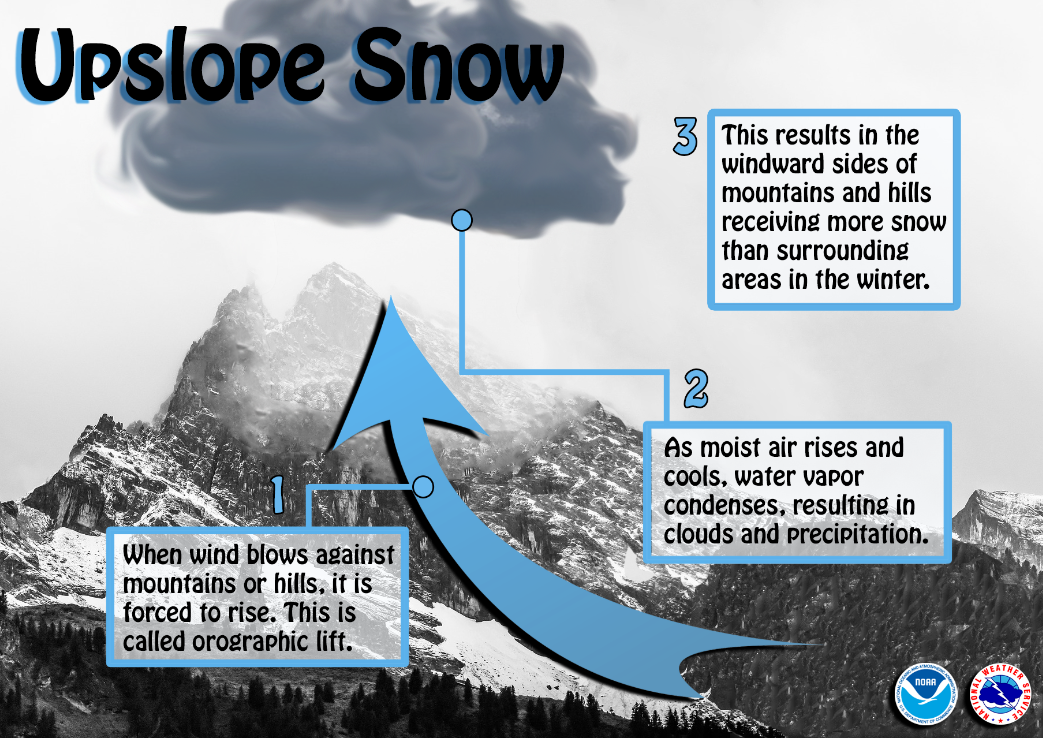
Facebook
Did you know that in the northern hemisphere, winter actually occurs when the Earth is closest to the Sun? This is possible because of the way the Earth tilts on its axis. During winter, the northern hemisphere is tilting away from the Sun, causing the Sun’s rays to hit the northern hemisphere at a lower angle, which results in far lower temperatures. Learn more at scijinks.gov/earths-seasons/
X
In the northern hemisphere, winter actually occurs when the Earth is closest to the Sun. Learn more scijinks.gov/earths-seasons/
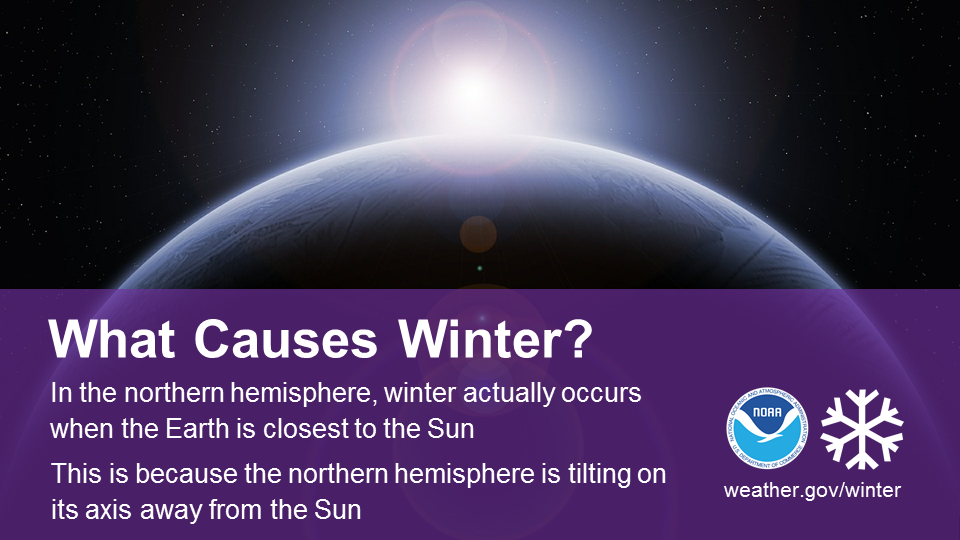
Facebook
Did you know that while no two snowflakes are exactly the same, they are all six-sided? Snowflakes’ hexagonal shapes are due to the molecular structure of ice. Learn more about the science behind snowflakes: noaa.gov/stories/how-do-snowflakes-form-science-behind-snow
X
Did you know that no two snowflakes are alike, but they are all 6-sided? noaa.gov/stories/how-do-snowflakes-form-science-behind-snow #SnowflakeScience

Facebook /X
Did you know that frost can form when the official low is above freezing? The official temperature is recorded around 6 feet above the ground, and in a strong temperature inversion on a clear night, ground temps can be 5-10℉ cooler than the air below that. youtu.be/HBn1oSWu2nE
Facebook
At certain times of the year, water from melting snow can be responsible for almost all of the streamflow in a river. The processes of snowmelt are crucial in forming accurate river flood forecasts. Learn more about flood science at weather.gov/flood .
X
At certain times of the year, water from melting snow can be responsible for almost all of the streamflow in a river. The processes of snowmelt are crucial in forming accurate river flood forecasts. Learn more about flood science at weather.gov/flood.
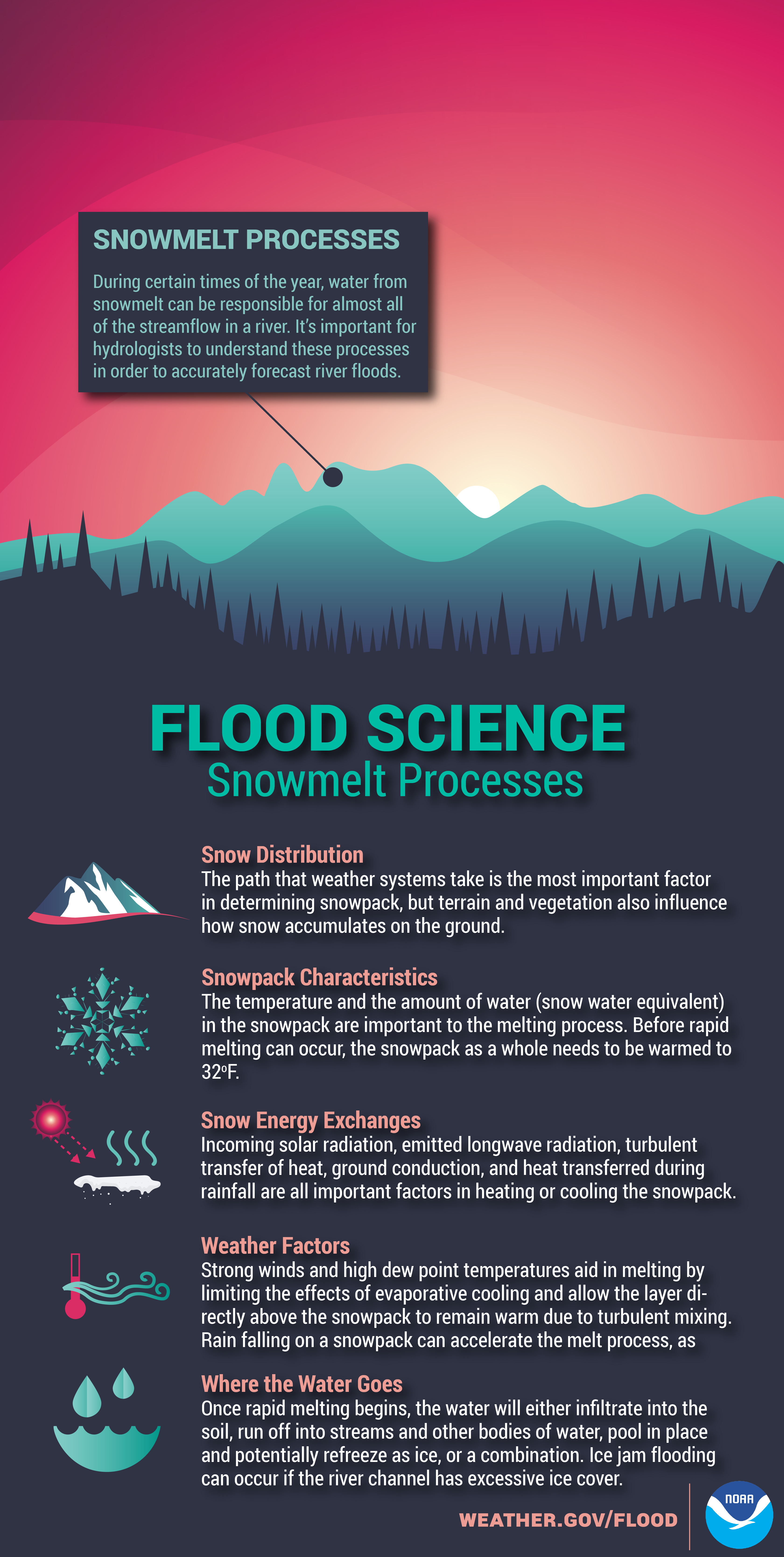
Facebook
During winter months, falling snow serves as an important source of freshwater across the world. When spring arrives, melting snow helps replenish rivers, lakes, and reservoirs. The melting snow adds much-needed moisture to the soil and helps refill underground aquifers, which are vital for growing crops and for drinking water. noaa.gov/jetstream/atmosphere/hydro
X
During winter months, falling snow serves as an important source of freshwater. noaa.gov/jetstream/atmosphere/hydro
